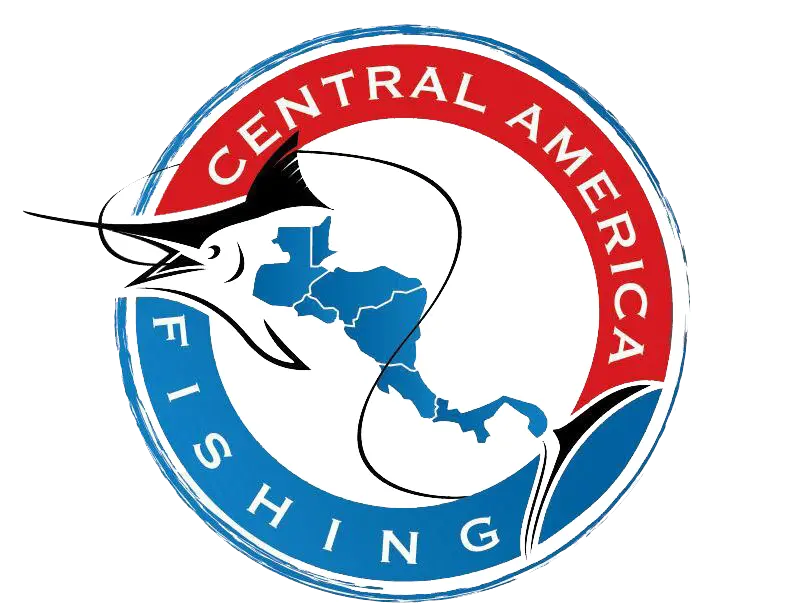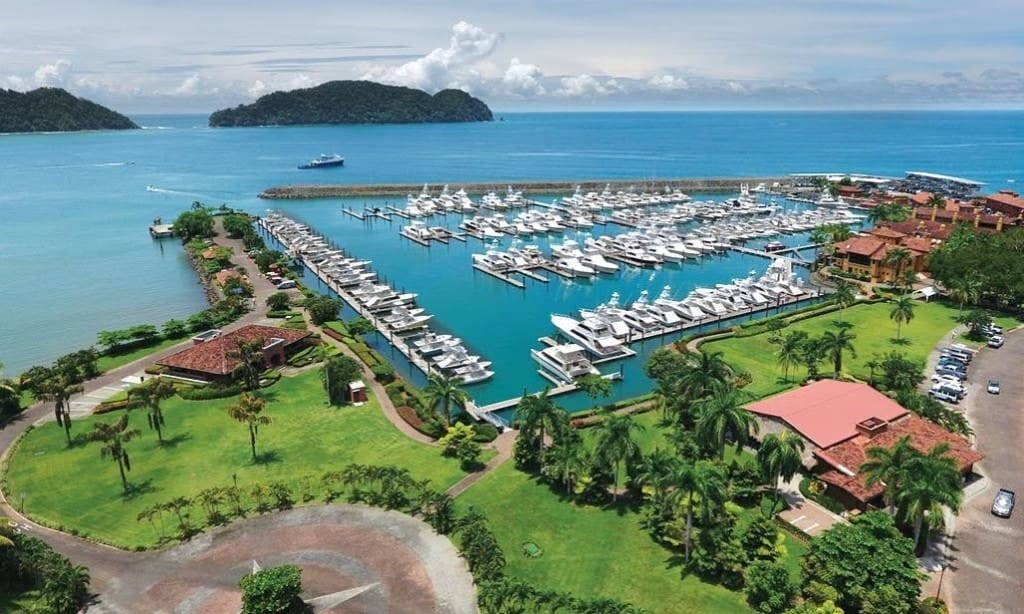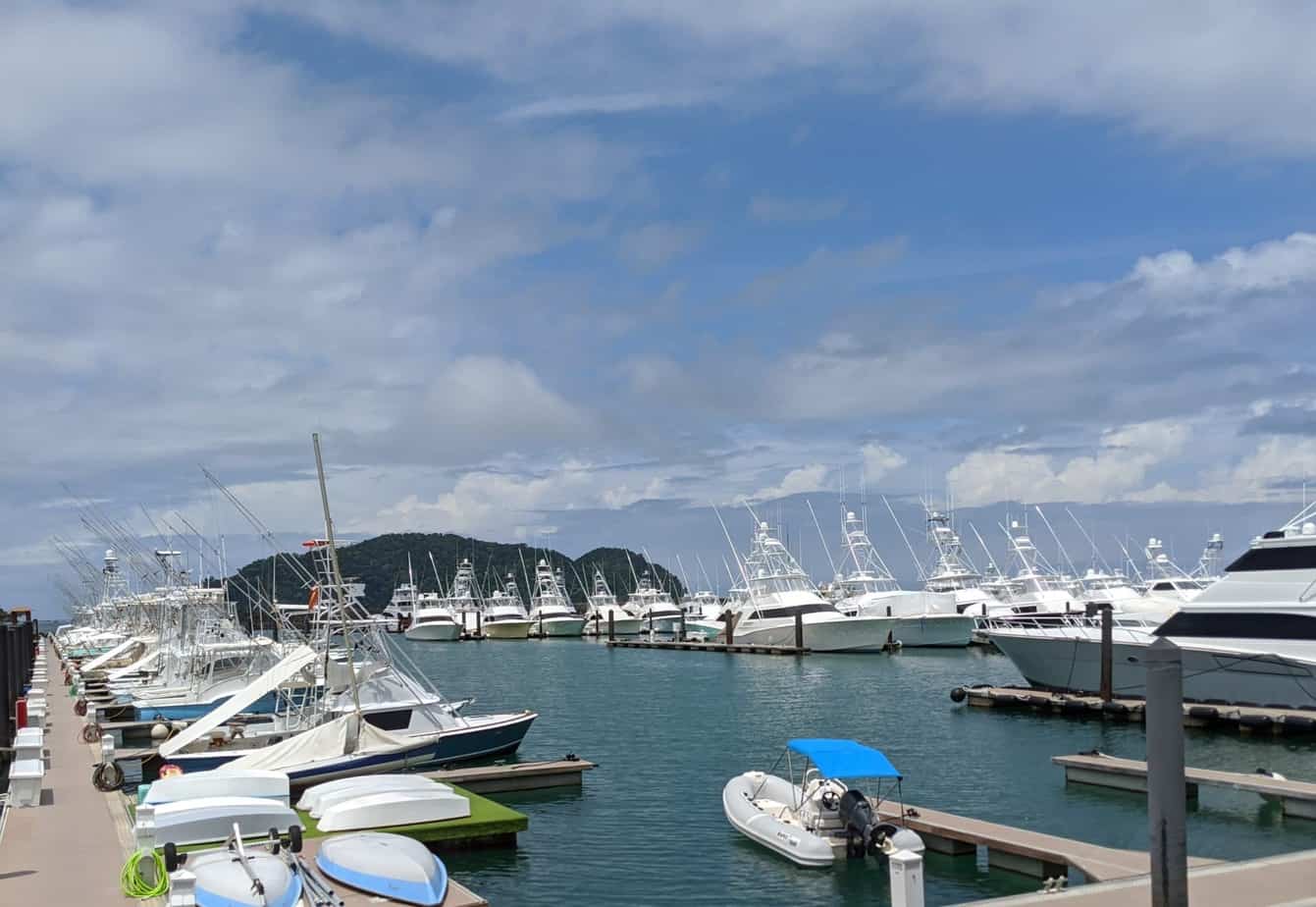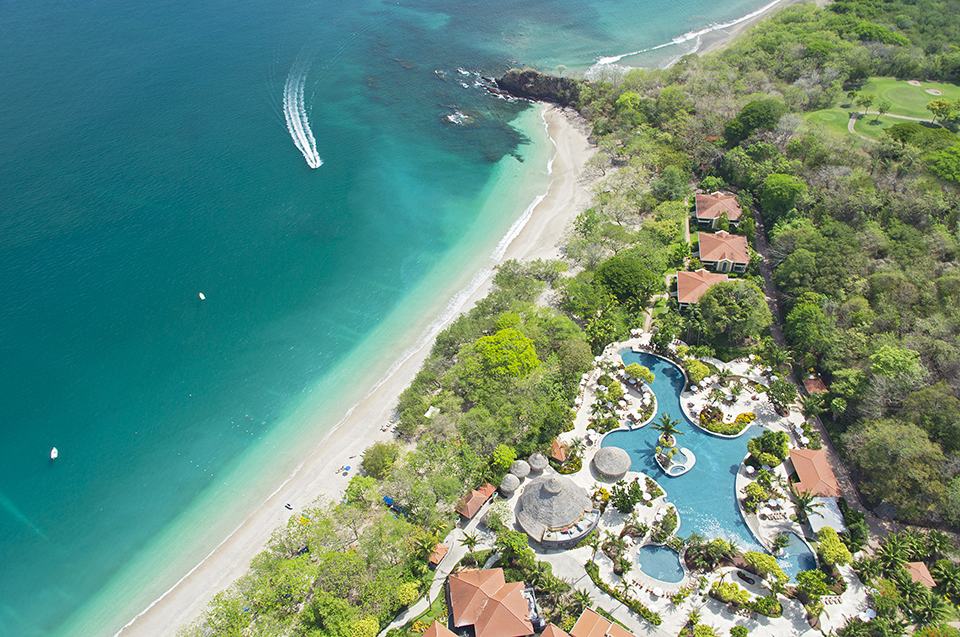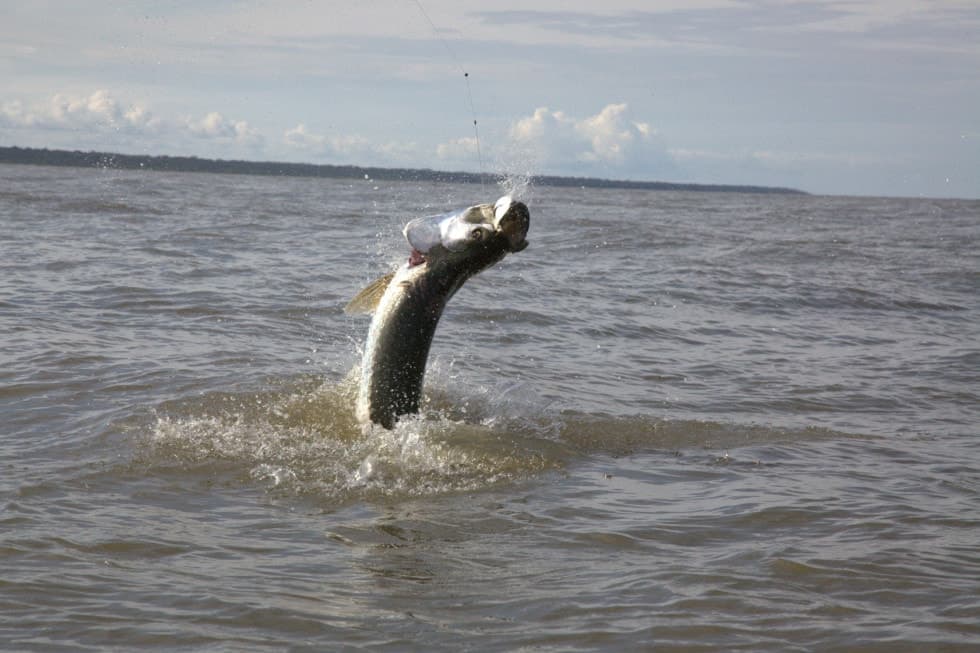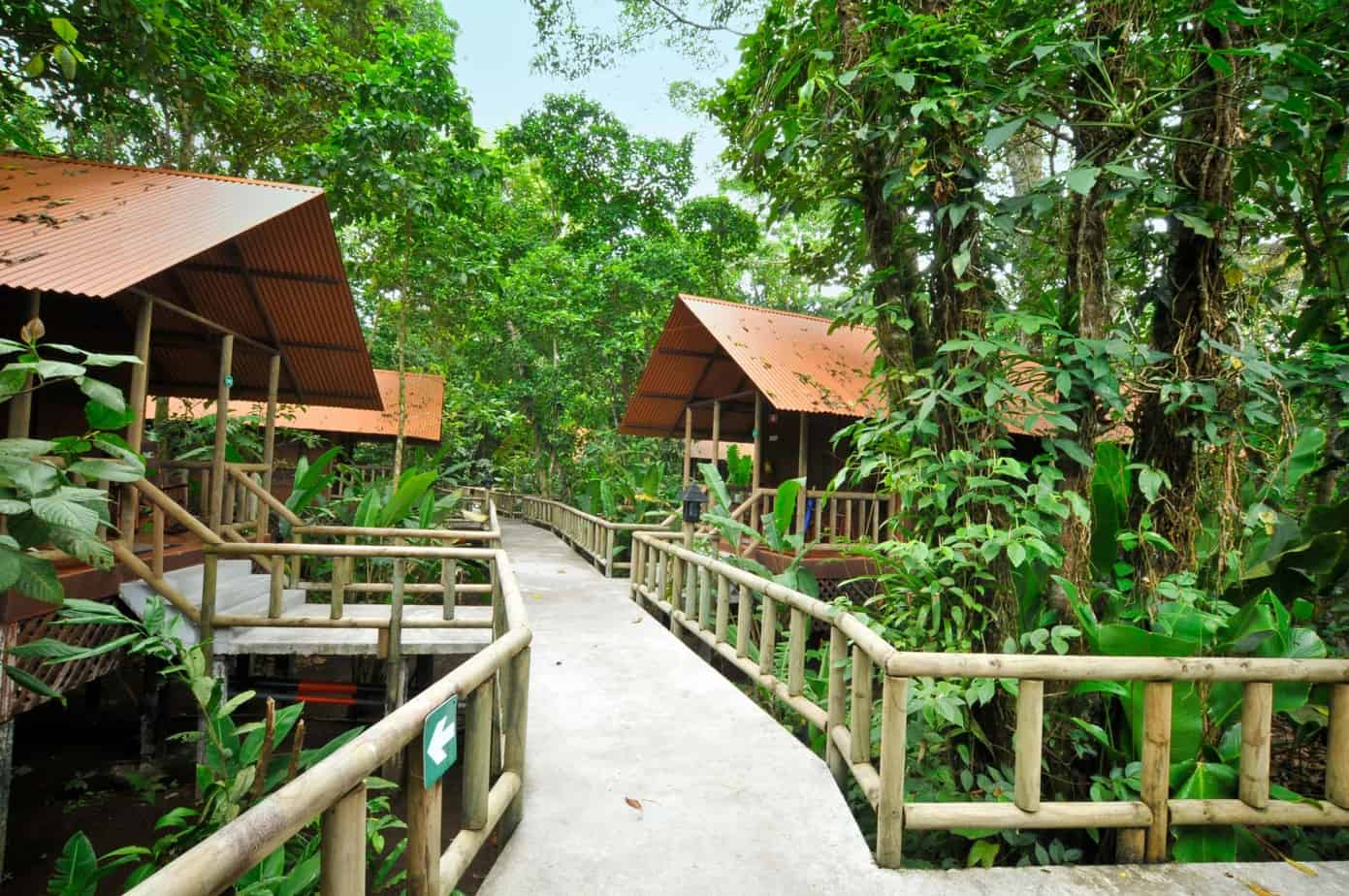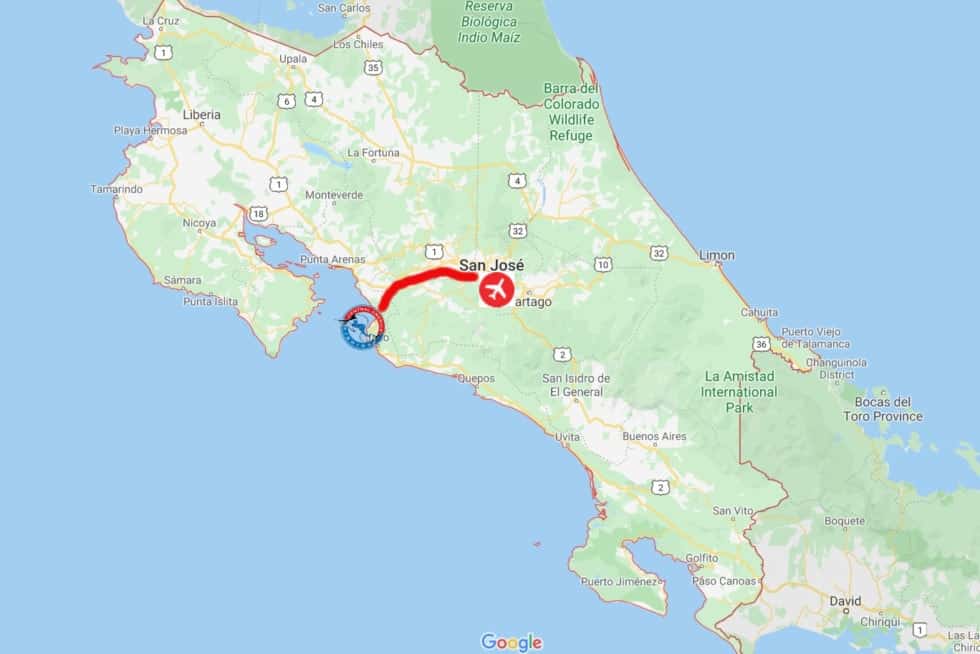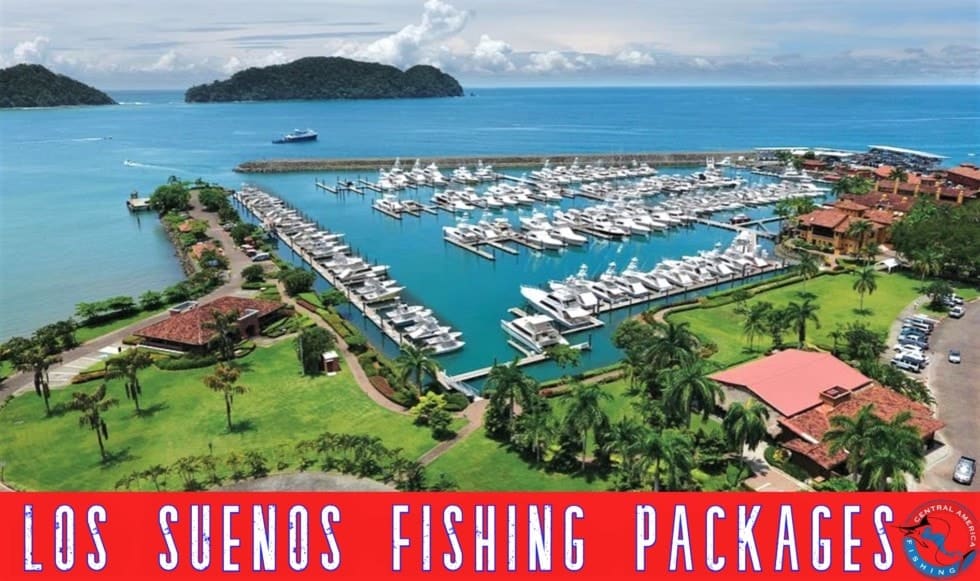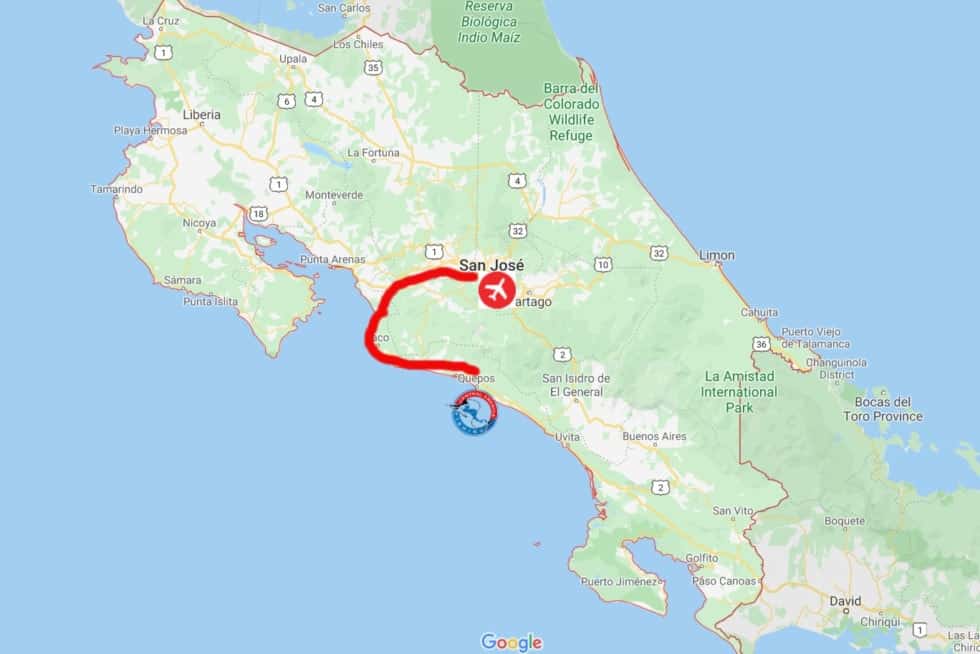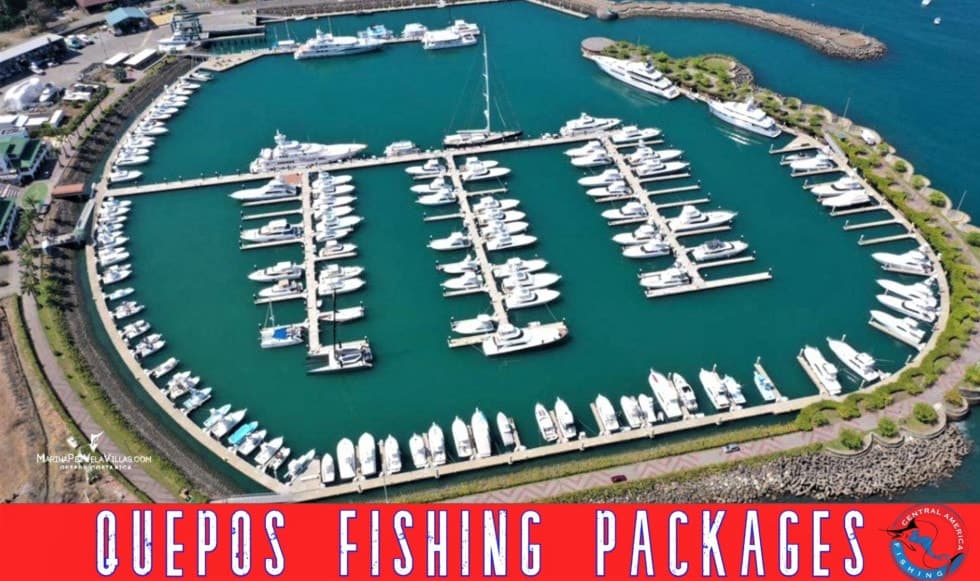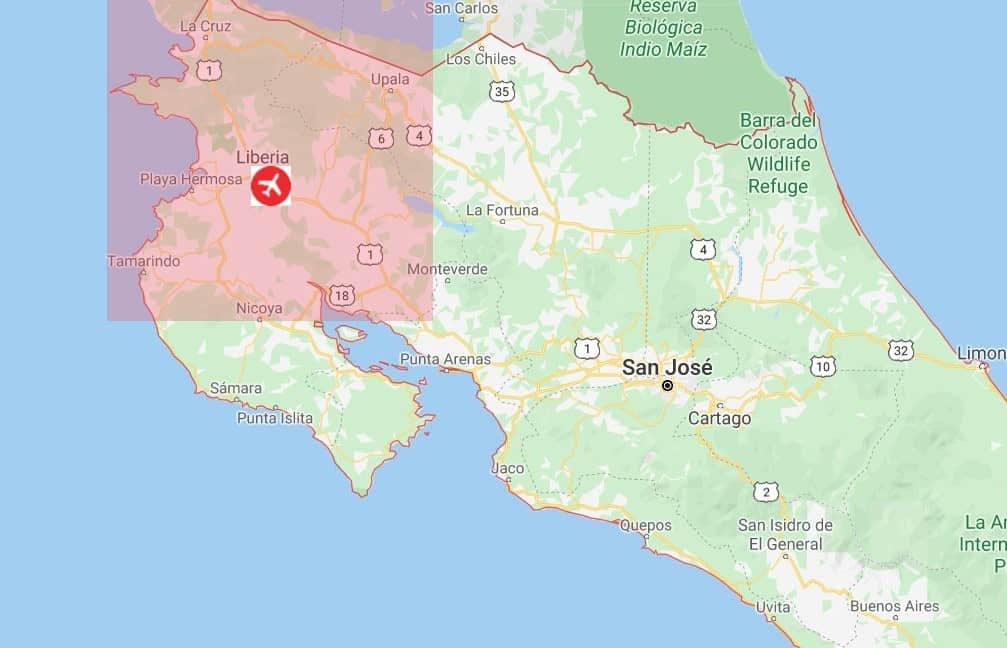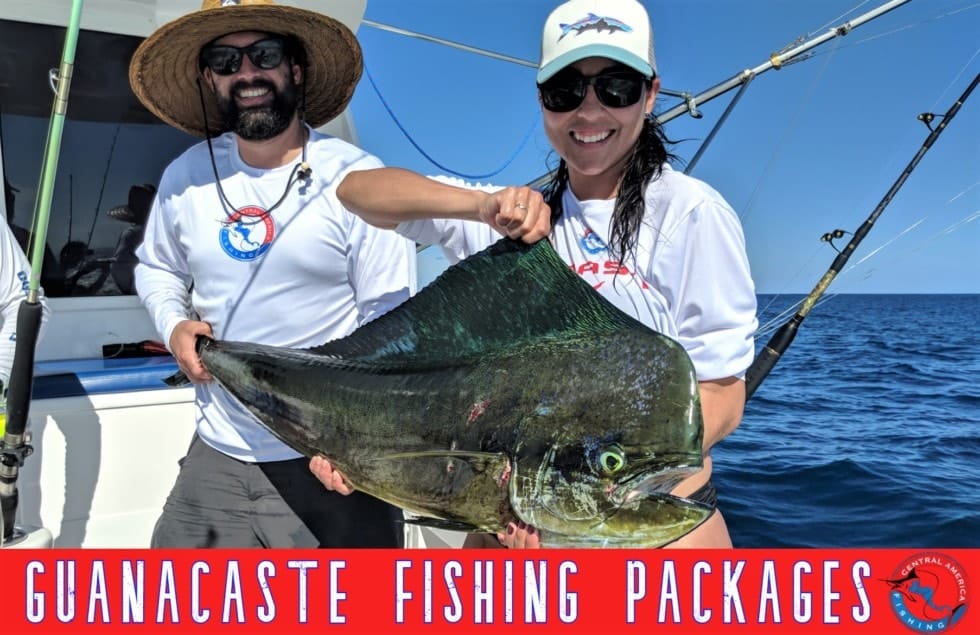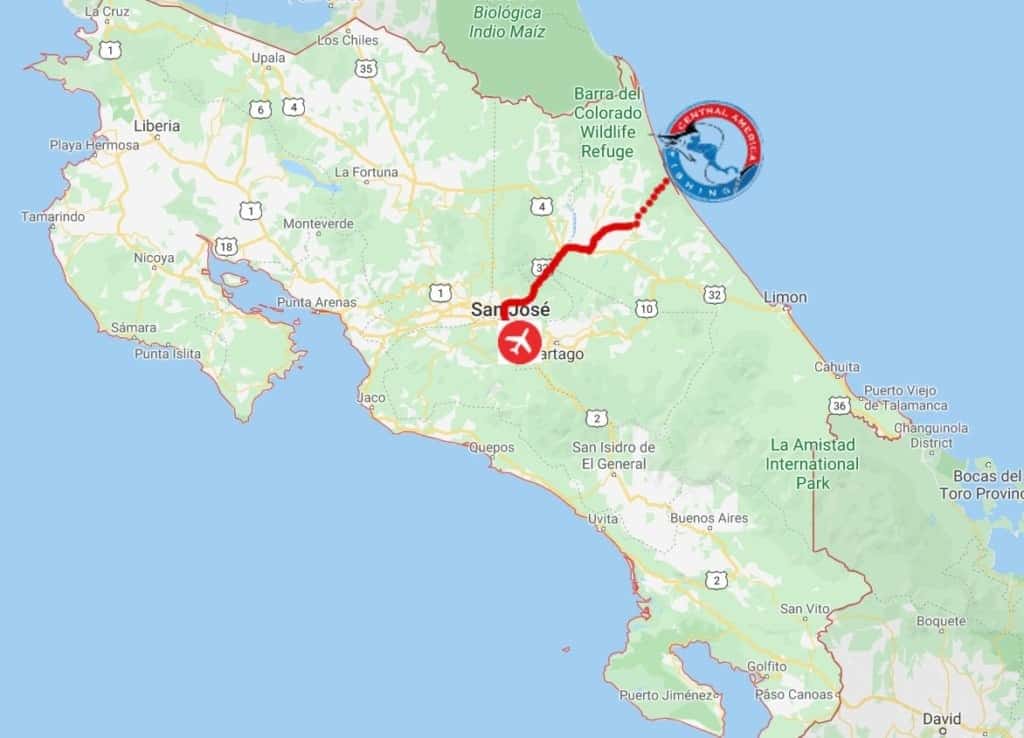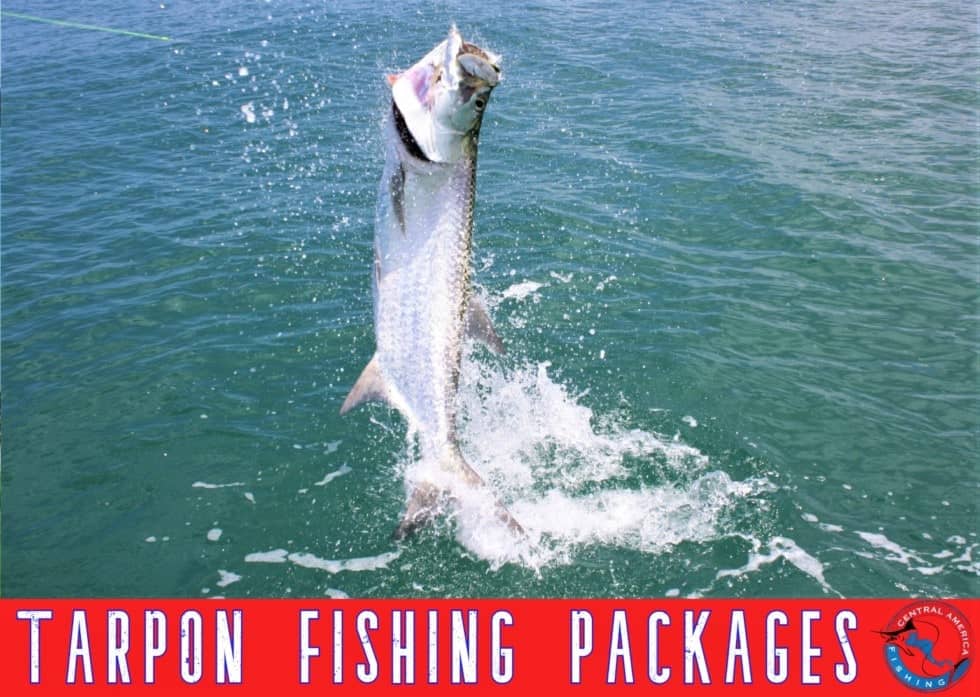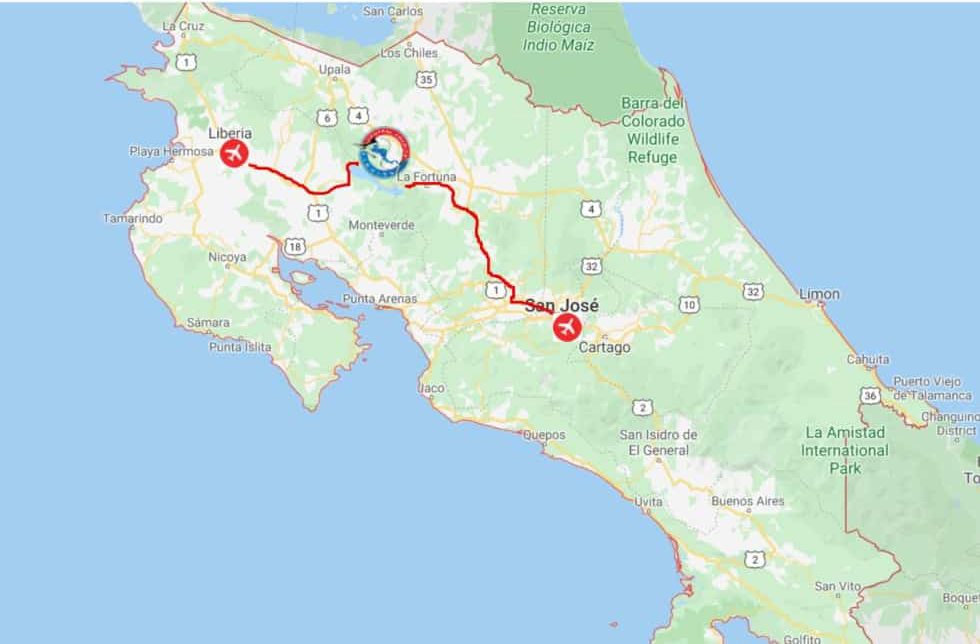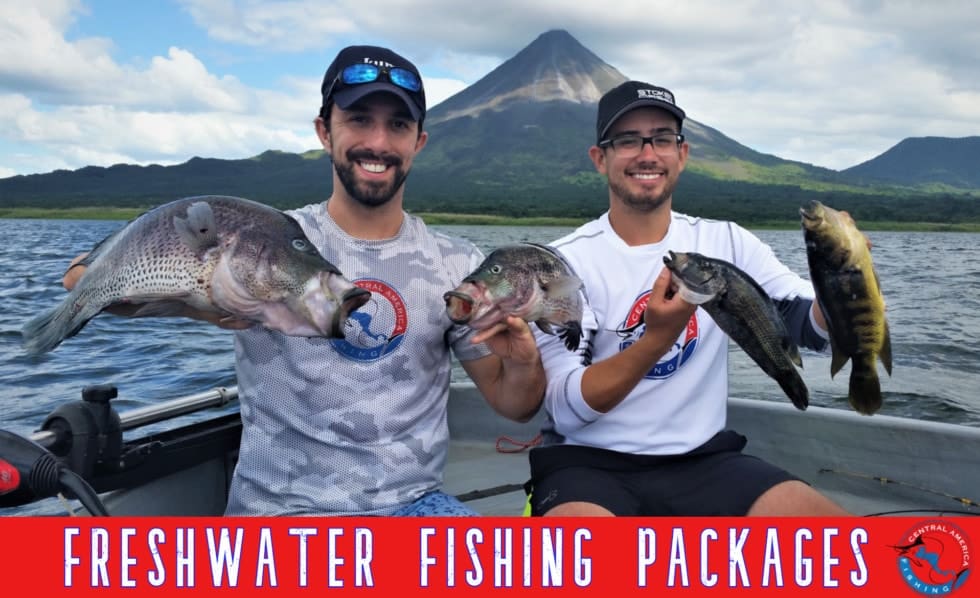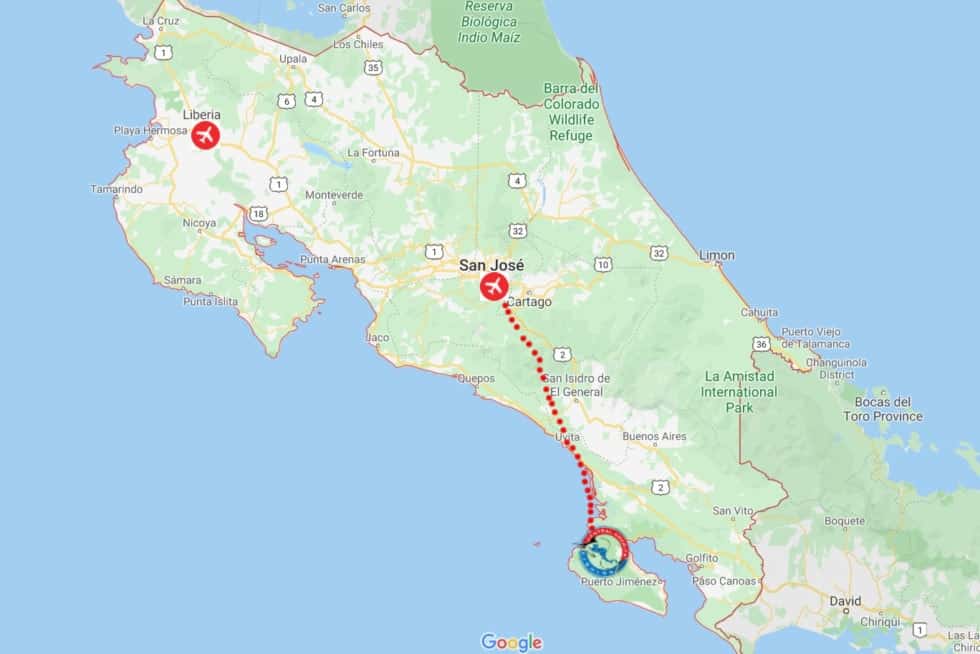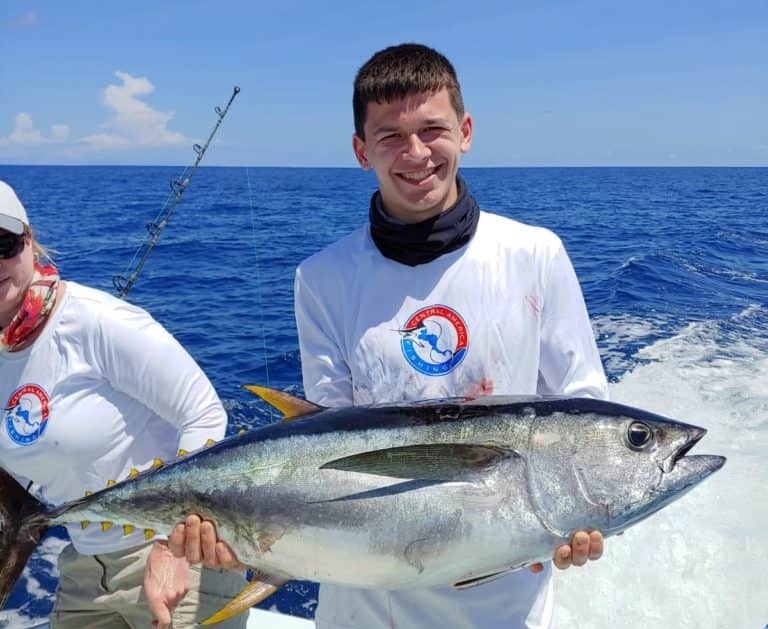Costa Rica Fishing Vacation
Packages
Fishing Info
Seasons
Destinations
Available Species
FAQ’s
Fishing in Costa Rica is some of the best sportfishing in the world with an unbeatable combination of quantity, quality, and diversity. The dream Costa Rica fishing vacation looks different to each angler with amazing offshore and inshore fishing along the Pacific Coast, incredible tarpon fishing on our Caribbean Coast, unique freshwater fishing venues, and a combination of trophy fish and exotic species to tangle with. Of course, none of this would be possible without the incredible local captains and fishing guides, all of which we have hand-picked for you to fish with. We know there is no set itinerary that is perfect for everyone, that’s why we customize every Costa Rica fishing vacation that we create. There is a lot to know about where to go and when, but we make it easy by offering the best fishing in Costa Rica with a selection of packages sorted by interest, species, and the most popular fishing destinations in Costa Rica. Once you inquire with us, we’ll work with you personally to customize your dream fishing vacation.
At Central America Fishing, we are the home of the best fishing vacations in Costa Rica. We are not a faceless online booking site listing cheap charter boats nor an affiliate marketing site full of links, we are a small team of professional vacation planners with over 20 years of experience living, working, and fishing right here in Costa Rica. Planning customized, luxury fishing vacations is literally what we do every day. Every single destination, accommodation, and fishing captain that we partner with we have personally visited and experienced first-hand before recommending the service to our own guests. Visit our social media pages, read our reviews, and watch our videos on YouTube and you’ll see why we are proud to say that 40% of our groups are repeat & referral guests
Costa Rica Offshore Fishing
Los Suenos Fishing
Quepos Fishing
Costa Rica Tarpon Fishing
Costa Rica Inshore Fishing
Costa Rica Fly Fishing
Freshwater Fishing
Costa Rica Fishing & Golf
Guanacaste Fishing
The Complete Local Costa Rica Fishing Guide
Costa Rica is a top destination for big game offshore fishing, light tackle inshore fishing, tarpon fishing, freshwater fishing, and even fly fishing. A country the size of West Virginia, it offers so many amazing fishing destinations and different fishing venues that you can vacation here several times and fish someplace new every visit. A large part of Costa Rica’s famous biodiversity and natural beauty are its lush coastlines on two oceans, the 33 sq mile Lake Arenal, and pristine jungle rivers – and we fish them all! With all these different species to catch, it’s also a paradise for fly anglers who want to take on new challenges on a fly rod.
The fact is, anglers have been fishing in Costa Rica since the 1980s, so it has been on the radar as an international fishing destination for several decades. Even I caught my first roosterfish in Quepos back in 2003 – over twenty years ago! Today the sport fishing industry plays an integral part of Costa Rica’s robust tourism industry, which is one of the top three industries in the country. In fact, studies from our conservation partners at the Billfish Foundation and FECOP have shown that the recreational sport fishing industry directly and indirectly generates $500 million USD annually for Costa Rica’s economy and creates tens of thousands of jobs. As a sport fishing outfitter with 20 yrs of experience planning fishing vacations in Costa Rica, we see this firsthand every day as our guests need transfers, tours, accommodations, and restaurants & bars to eat at.
Ever since the Los Suenos Resort & Marina opened in 2001, the popularity of fishing in Costa Rica has increased year after year. In fact, now there are several first-class marinas along the Pacific Coast including Quepos, Flamingo, Papagayo, and Golfito, many of which host international fishing tournaments. As much as Costa Rica is known as a leader in eco-tourism, it is equally recognized as one of the world’s most popular sport fishing destinations – and that shows no sign of changing any time soon.
Offshore Fishing in Costa Rica
The incredible sport fishing in Costa Rica starts with the offshore fishing on the Pacific Coast, which is what put fishing in Costa Rica on the map several decades ago. Costa Rica is one of the few places on Earth where you can legitamately expect double digit sailfish bites a day in calm, 1-2 ft seas during our peak season. We also have opportunities for black, blue and striped marlin throughout the year. The billfish bite here is so consistently good, Costa Rica has earned it the nickname “the Billfish Capital of the World.”
Blessed to be at the convergence of two major ocean currents, the waters where we deep sea fish in Costa Rica have a near constant presence of baitfish and oxygen-rich water. With the continental shelf being just 10-20 miles off the Pacific Coast, a typical run to the offshore fishing grounds is usually just 60-90 minutes until you have your lines in the water. Thanks to new commercial fishing laws, Costa Rica also boasts a healthy population of yellowfin tuna and dorado (mahi-mahi). In 2014 the “tuna decree” was passed that moved commercial purse-sieners out to 45 miles. Most charter boats in Costa Rica have a 50-mile limit anyway, so protecting the most important fishing grounds from the commercial fleet led to massive rebound in tuna and mahi populations. That presidential decree was not only officially turned into law in 2018, it also pushed the commercial fleet even farther out to 80 miles. In the past, we used to only catch tuna during our green season months, but now we literally see them every week of the year.
Not only are there more fish, the size of the fish we catch has been noticeably better the past few years. Panama used to be the only place to go to catch a trophy “cow” tuna, but there have been more 100-200 lb tuna caught the past few years than I’ve seen in my 20 years fishing in Costa Rica. The mahi have also been given a chance to grow to trophy size, with 50″ to 60″ monsters now a somewhat common occurrence each year.
Trolling Dead Baits
Without a doubt, the most effective method utilized while offshore fishing in Costa Rica is trolling dead baits rigged on circle hooks. The main bait used is the ballyhoo, which are either caught and bought here in Costa Rica or even shipped in from Florida. Our top charter boats will have trays of pre-rigged ballyhoo ready to fish in the cooler on the deck, plus multiple extra bags frozen in case the bite really turns on. When billfish is the main target for the day, many of our top charter boats will also have a bonito or mackerel rigged up to use as a pitch bait in case a hungry marlin crashes the scene looking to eat something bigger than a ballyhoo.
The most common way to troll ballyhoo is by setting a spread with a plastic teaser and two to three ballyhoo in the water on each side of the boat. The ballyhoo are typically fished behind and outside of the teaser (long line), one fished infront and inside of the teaser (short line), and then some deploy a third just off the transom as a pitch bait. Some of our higher end charter boats will also troll dredges behind the boat to try and raise more fish.
Slow Trolling Live Baits
Trolling live baits while offshore fishing in Costa Rica is a tactic most commonly used when fishing for marlin. Bonito, a small species of tuna, is the ideal live bait while offshore fishing and since they are plentiful, hearty, and can be kept alive for hours in the tuna tubes that many of our top offshore fishing charters are equipped with. Blue runner, or “cojinua” as they are called here, are also great live baits and can be kept alive in a livewell for the entire day. While larger sailfish can eat a bonito, the size of the bait tends to ward off 90% of sailfish and leave the bait swimming for the larger marlin. If we find a school of yellowfin tuna that are feeding but won’t take a lure, slowly trolling live bait is a great way to elicit a bite. The cojinua work great on all sizes of fish, but if you really want to battle a “cow” tuna over 200 lbs, targeting them with a live bonito is the way to go.
When fishing live bait, we troll at slower speeds so that the baitfish aren’t dragged and drown. We also typically only troll a couple of live baits at a time beause, as these fish are still alive and swimming, it is easy for lines to get tangled up if there are too many in the water at the same time.
Trolling Hard Baits & Swim Baits
Trolling hard baits, like big rapalas, is the tried and true way to catch wahoo in Costa Rica. These must be trolled at speeds faster than when trolling dead baits to elicit bites and you need to be rigged with a wire leader, otherwise you will lose a lot of expensive lures to sharp wahoo teeth. This most commonly works when trolling above pinnacles and around offshore islands. We can also troll swim baits in search of dorado when we find a trash line or a natural FAD like a large tree, which are most common during our green season months. Islander baits with skirts can also be very effective for wahoo, tuna, and dorado.
Popper Fishing
Catching a yellowfin tuna on a top water popper is the ultimate experience. The explosion of water and ensuing reel scream will get any angler’s heart pumping. The holy trinity of fishing for tuna with a popper is the choatic scene of birds diving into the water, spinner dolphins jumping everywhere, and tuna busting through the surface as they feed. When we find this scenario, anglers can cast poppers (or swim baits) on spinning rods and then prepare for a grueling battle.
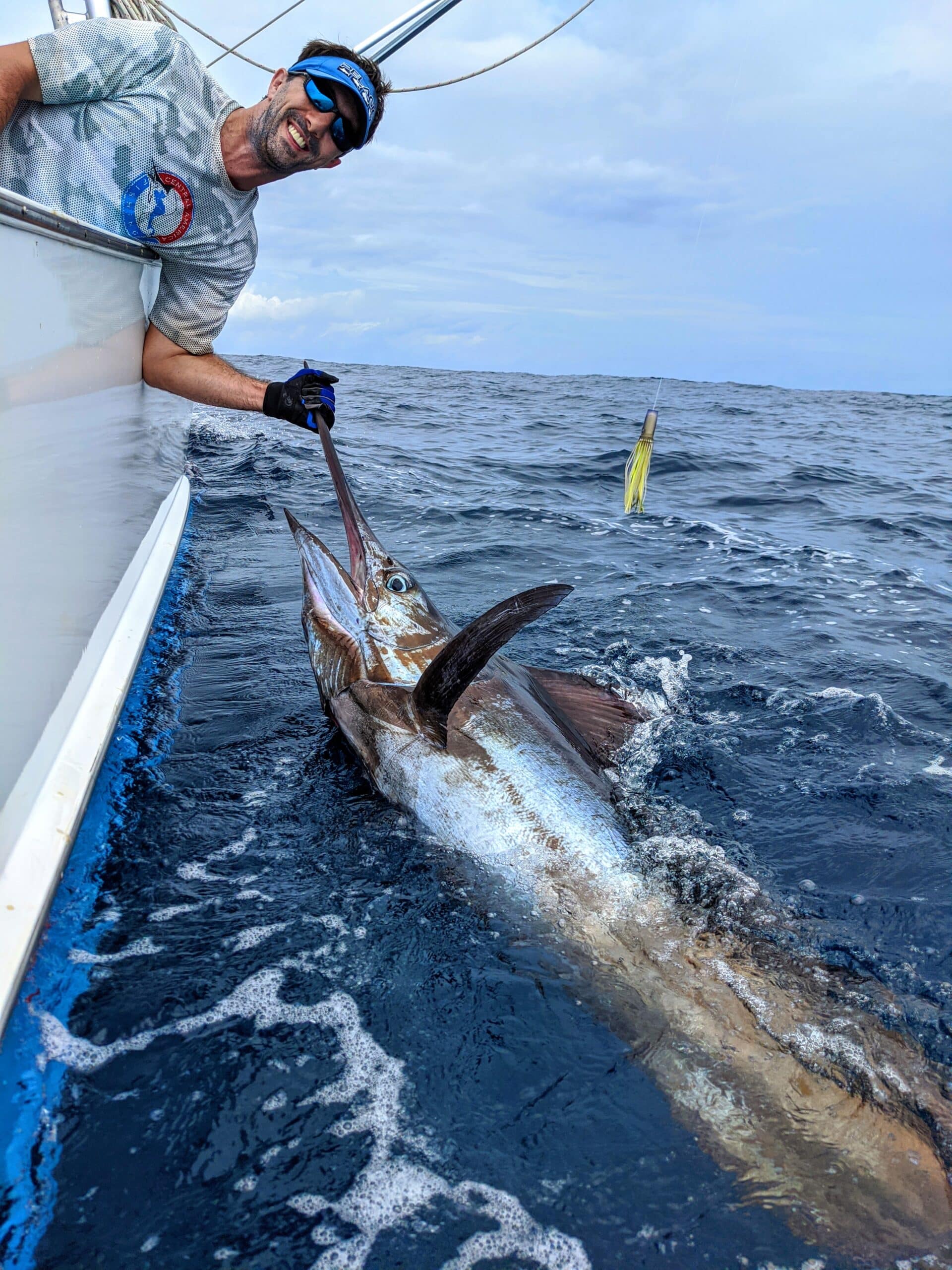
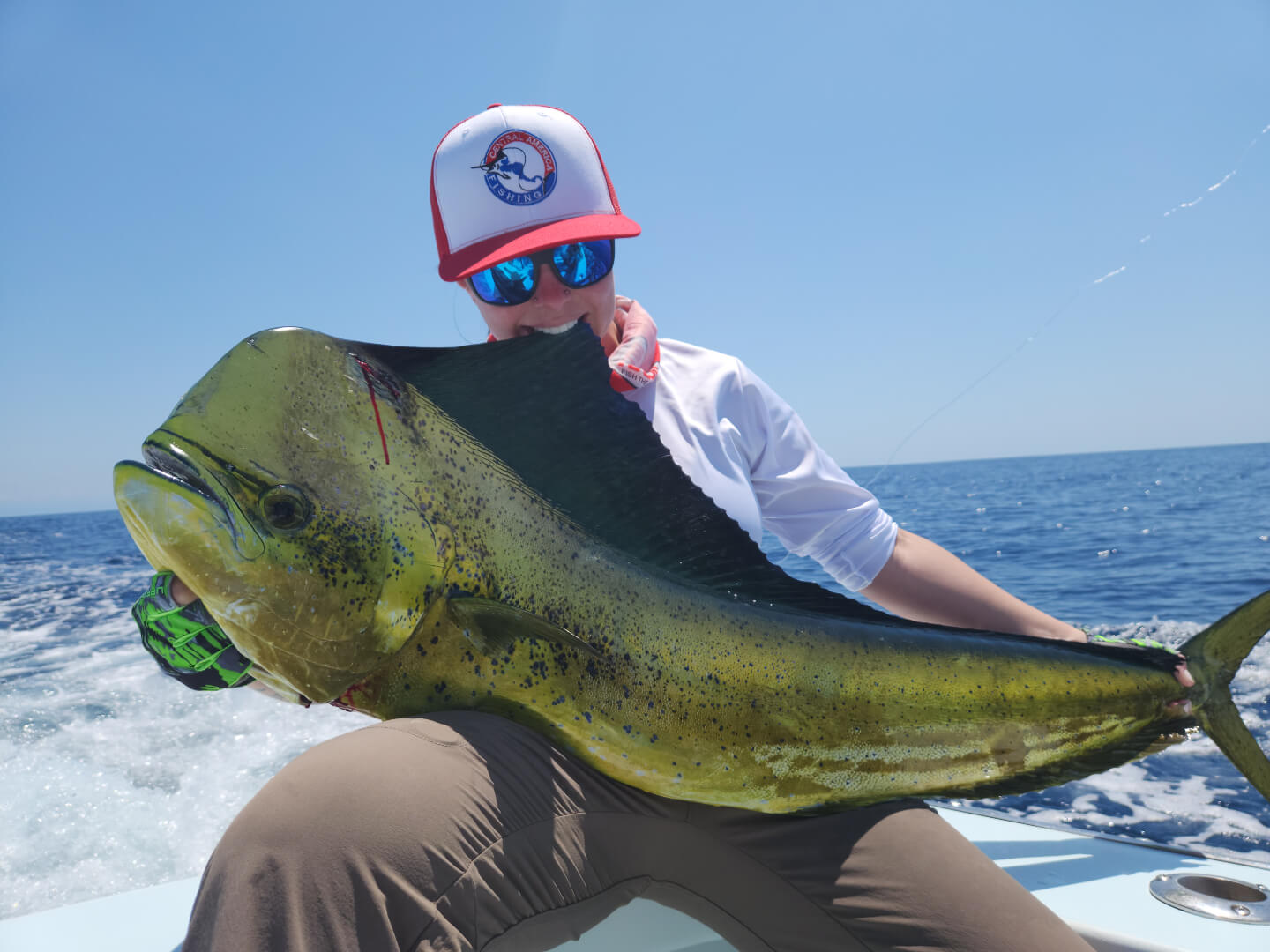
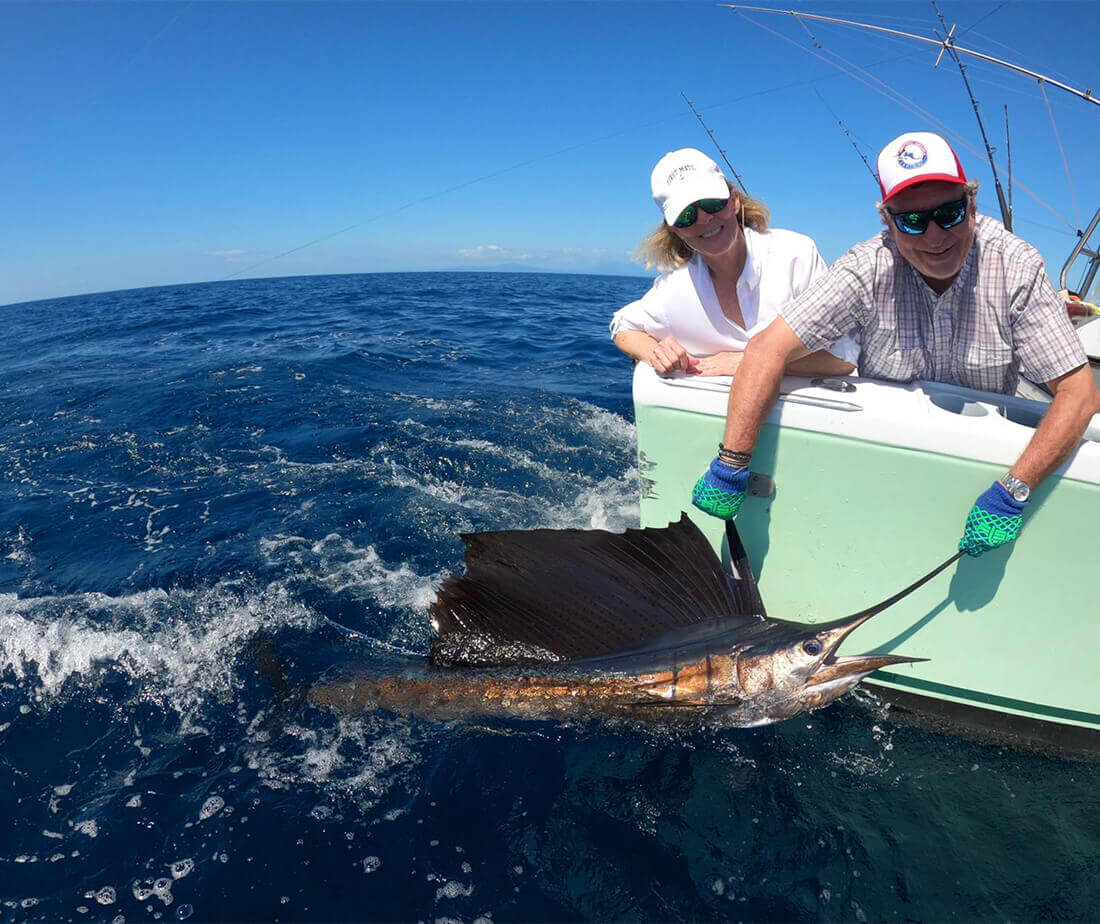
Inshore Fishing in Costa Rica
The inshore fishing in Costa Rica is every as exciting and productive as the big game offshore fishing that steals most of the headlines. On our Pacific Coast, we can catch over 20 species of fish including three kinds of jacks, mackerel, grouper, several species of snapper, sea bass, and large Pacific snook in the river mouths. For most, the main prize while inshore fishing in Costa Rica is the famous roosterfish, which we catch 12 months a year all over the country. On the Caribbean Coast, we have some of world’s best tarpon fishing. Bottom fishing is also extremely productive for snappers, groupers, amberjacks and other edible species. The inshore fishing is so good here that Costa Rica is actually home to numerous IGFA world records for inshore species, including several for Pacific Snook, common snook, and as recently as 2023 a new record for tripletail was caught here.
Thanks to its volcanic history, Costa Rica’s Pacific Coast is dotted with rocky islands, reefs and pinnacles that provide the much-needed structure that our inshore gamefish need. There are also countless river mouths and estuaries that hold bait and attract predators at the changing of the tides. Costa Rica’s Caribbean Coast lacks the vibrant, shallow coral reefs that other Central American countries enjoy, so the main structure are the huge river mouths that line the coast. While you main run north or south along the coast, when you are inshore fishing in Costa Rica you are almost aways within site of land and generally no more than a few miles off the coast.
Fishing with Live Bait
The most effective inshore fishing in Costa Rica is done with live bait. The most popular options include blue runners, lookdowns, sardines, and even bonito. Slow trolling blue runners or lookdwns around rocky islands and over reefs is the most productive way to catch our popular roosterfish. When targeting snook in the surf, casting a live sardine is too much of a temptation for them to pass up. Live bonito can also be bump trolled over pinnacles and rock piles for big cubera snapper and trophy-sized roosterfish. Just be aware that if you put a tasty bonito down into the strike zone, it’s entirely possible that anything from an amberjack, sailfish, or even a marlin will take it.
Popper Fishing
The most popular method of inshore fishing that our anglers ask for is popper fishing. From bass fishing on a pond to a 50 lb cubera snapper, who doesn’t love a good surface strike? A properly worked popper can elicit bites from cubera snapper, three types of jacks, mackerel, Pacific barracuda, and of course everyone’s dream – roosterfish. Popper fishing isn’t exclusively limited to casting towards the rocks and islands, some days we can also cruise just behind the surf break and cast into the white water.
Casting Swim Baits
Right after popper fishing, our anglers also love to cast swim baits while inshore fishing in Costa Rica. It is less technical than popper fishing, and sometimes more productive as the swim baits will be deeper in the water column for the fish who don’t want to eat at the surface. From deep divers to crystal minnows to spoons, there are a variety of shapes, sizes, and colors that elicit bites from our best inshore game fish.
Jigging
Jigging on light tackle is always a popular method with our anglers. An effective way to both fish at greater depths than lures or bait can reach, it’s also an effective way to fish the entire water column. Jigging can be done to target bottom dwelling species like some snappers, groupers, and amberjacks, but it can also catch a lot of fish that are feeding in 30-50 ft of water too. Both slow jigging and speed jigging are practiced here.
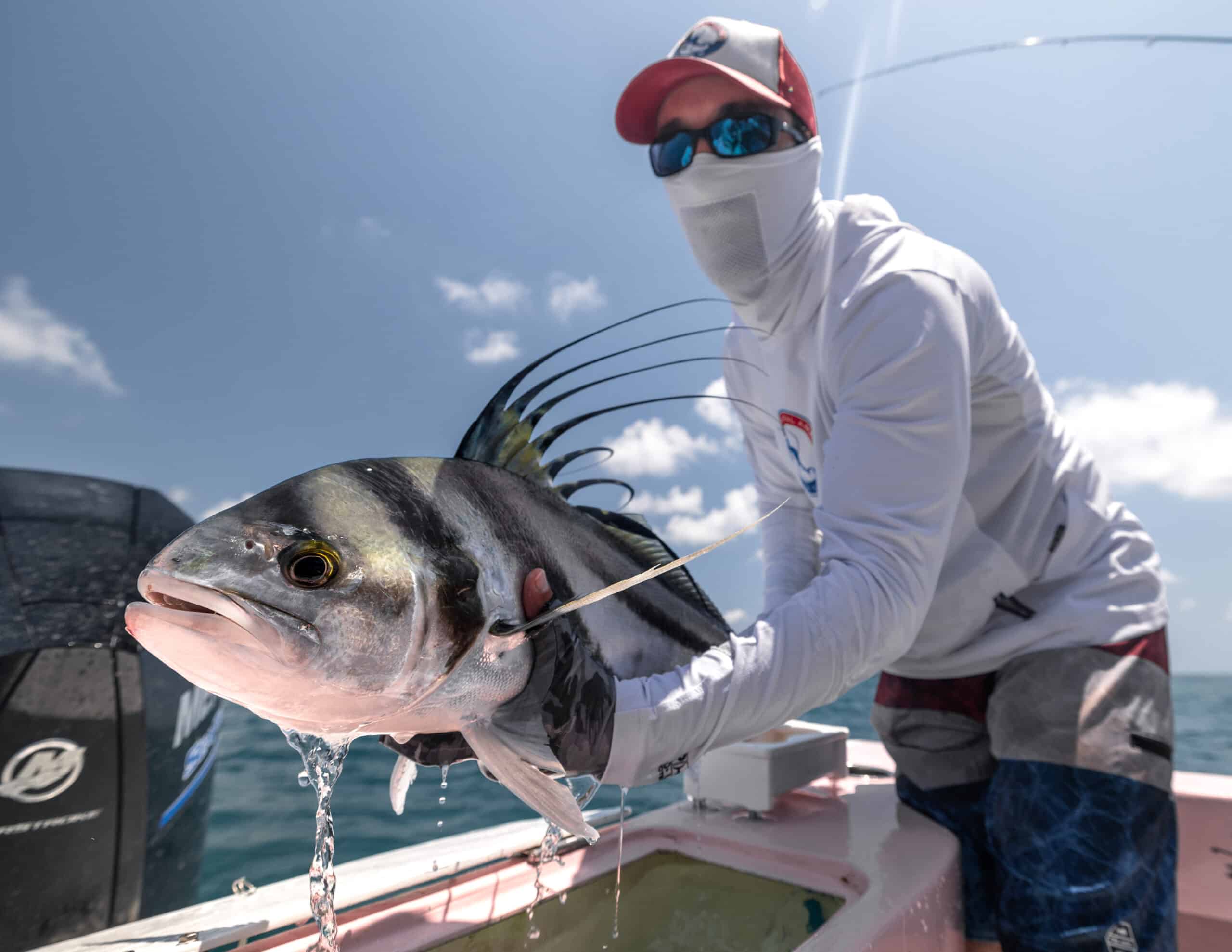
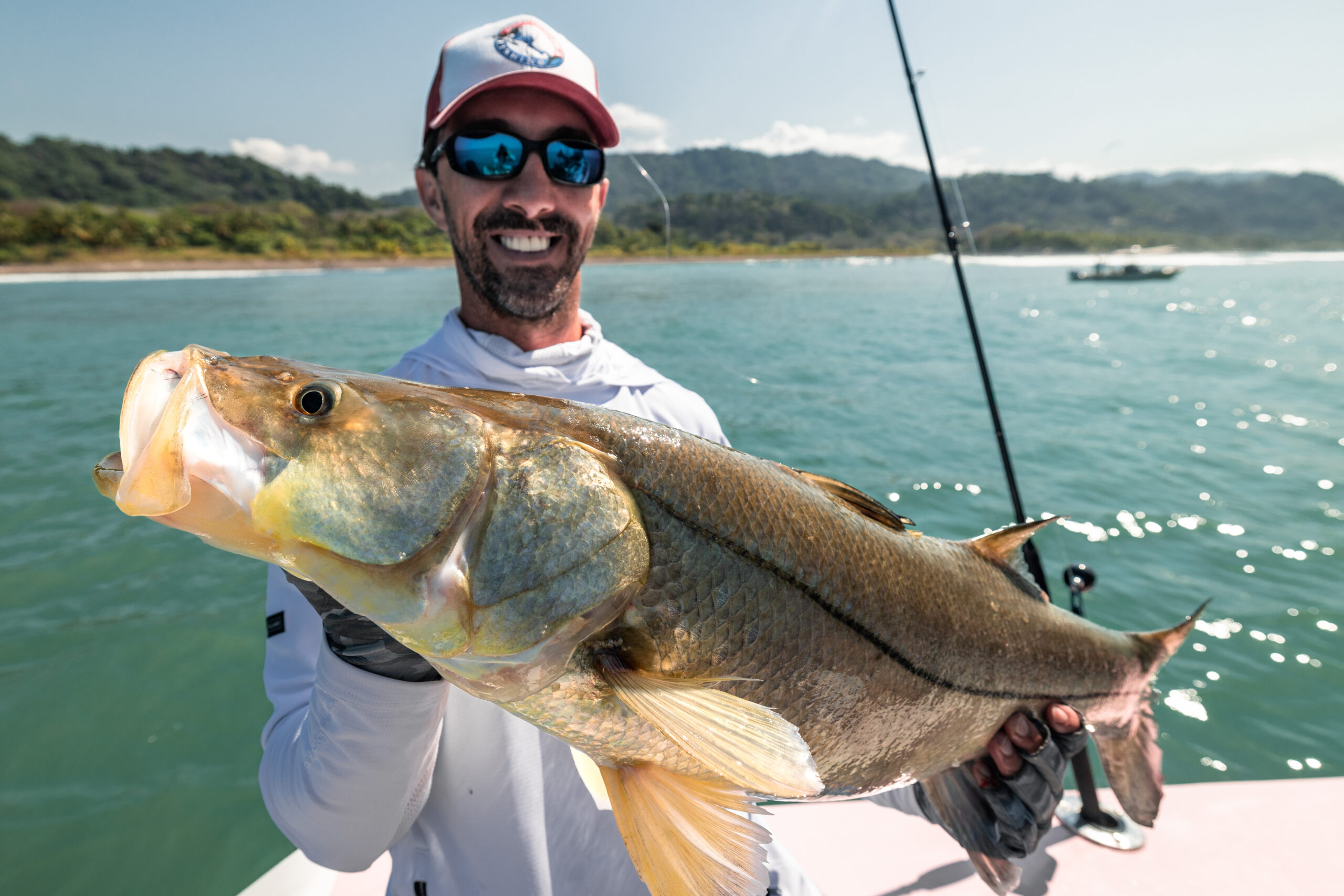
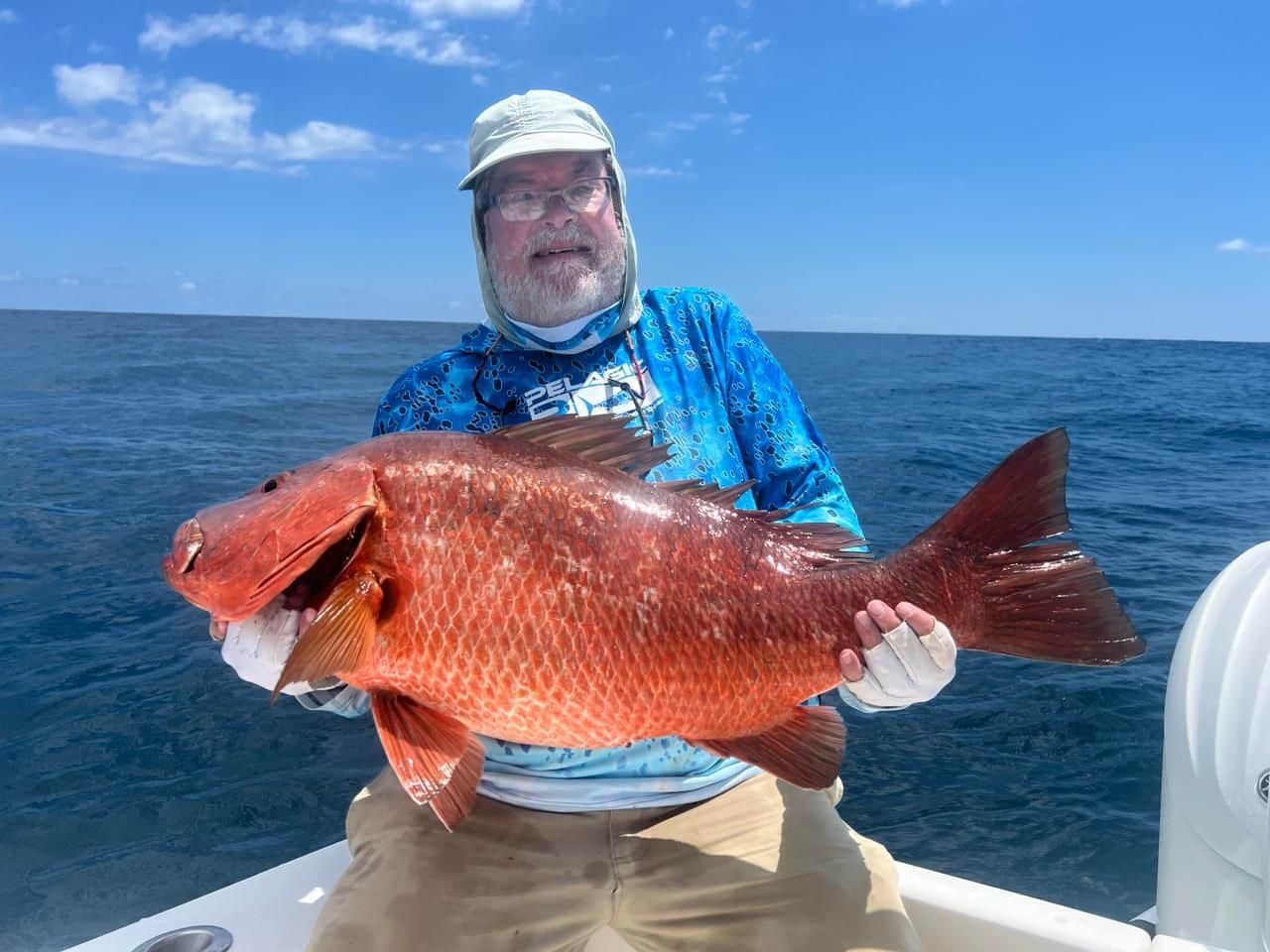
Tarpon Fishing in Costa Rica
The tarpon fishing along Costa Rica’s Caribbean Coast is considered to be some of the best in the world due not only to the numbers of fish, but the size of them as well. The tarpon population in Costa Rica is not migratory like other spots throughout Central America and the Caribbean, so the fish are almost always here. The main reason why is because the fish here are mainly mature adults, so when tarpon fishing in Costa Rica be prepared to do battle with fish that average 80-100 lbs. Larger fish of 150-200 lbs are hooked every year, but those trophies are much harder to land. The best tarpon fishing is done in the murky water of the river mouths along the coast, where drifting sardines in the currents or jigging bucktail jigs is most effective. The tarpon fishing is so consistently productive that this is one of the best places to go fly fishing for tarpon. Costa Rica tarpon fishing has been popular with anglers since the 1980s as we have a couple of tarpon lodges that have been around for 40 years. All tarpon are catch and release, but snook can be kept for a fresh seafood dinner.
Jigging for Tarpon
The tried and true method for catching tarpon in Costa Rica is jigging. Bucktail jigs with a 1/0 or 2/0 hook that feature bright colors and contrasts like red, yellow, white and pink work well when mixed in with blacks and purples. Adding a soft rubber swim bait to the jig can also help make it look more enticing. The waters along the cost can range from 20 ft to 80 ft, so by jigging we cover the entire water column.
Using Bait to Catch Tarpon
The most popular bait amongst our tarpon guides are sardines. The nice thing about sardines is that they are effective dead or alive, so all you need is to put a 7/0 or 8/0 circle hook through the back of a sardine and then drift it with the current. Sardines are not always available however, so this is not a guarantee on your charter boat.
Rapalas and Swimbaits for Tarpon
Unfortunately, we do have days where you simply aren’t able to make it out of the river mouth into the ocean due to high seas and winds. When this happens, the classic Costa Rica tarpon fishing method is to anchor in the river mouth and cast out big rapalas. The strong currents will take your lure into the feeding zone and provide all the movement your swimbait needs. The tarpon are constantly passing in and out of the river mouth as they feed, so sooner or later you’ll get a strike. This is a fun way to jump tarpon, but actually releasing them is difficult as they are pretty adept at throwing a treble hoook from their money mouths.
Fly Fishing for Tarpon
Costa Rica is one of the best spots in the world to fly fish for tarpon due to a healthy, resident population of big mature fish. Our tarpon avearage 80-100 lbs, so a 12 wt – 14 wt rod with a large arbor reel is needed. Unlike spots in the Caribbean where you can sight cast to fish, in Costa Rica you’ll do a lot of blind casting. Due to the deeper, murky water where we fish around the river mouths, we recommend a sinking or intermediate sinking fly line so that your fly can work deeper in the water column. Big streamers with a contrast in color like chartreuse & white, red & white, or orange & white with some flash usually work well
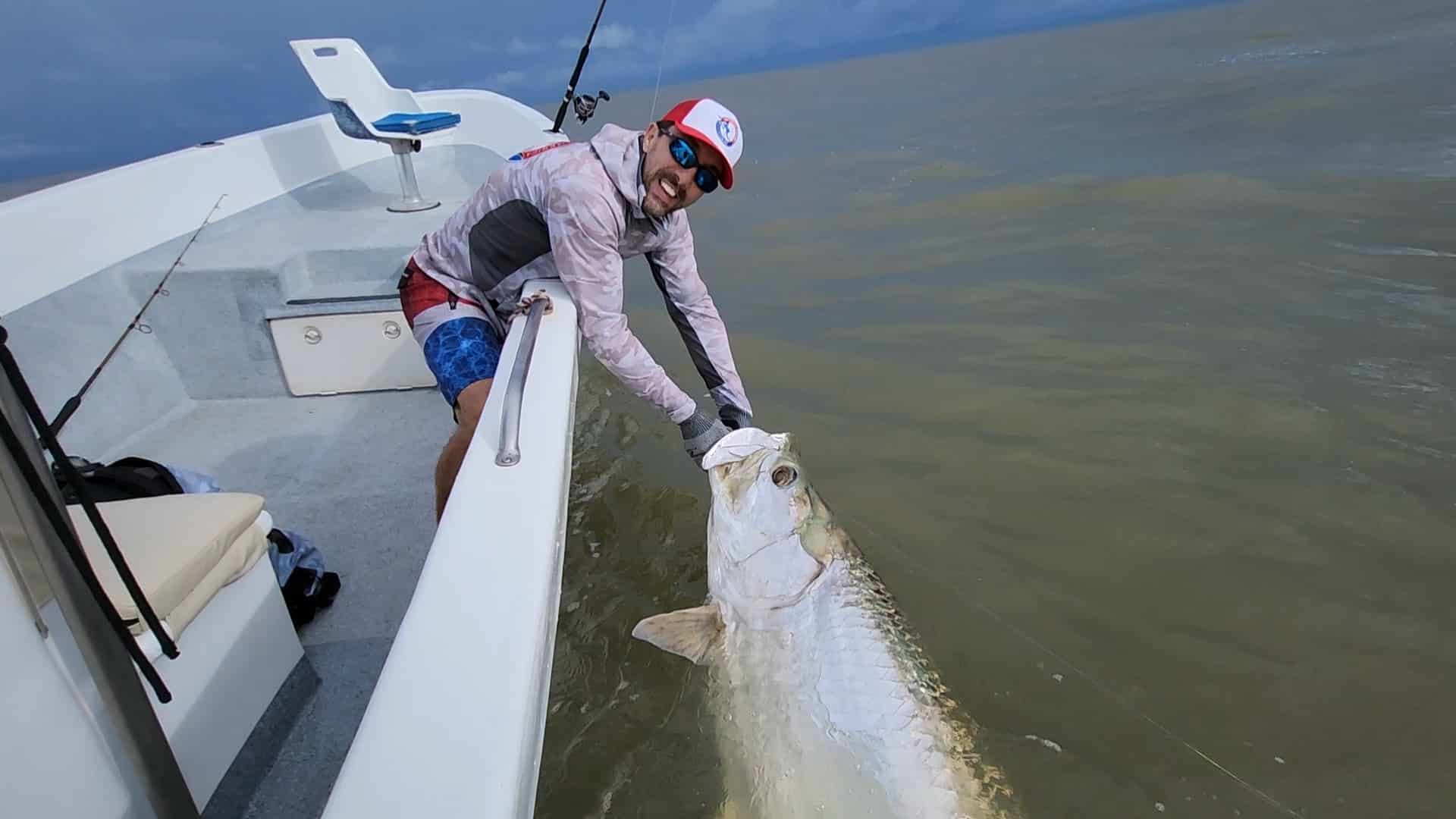
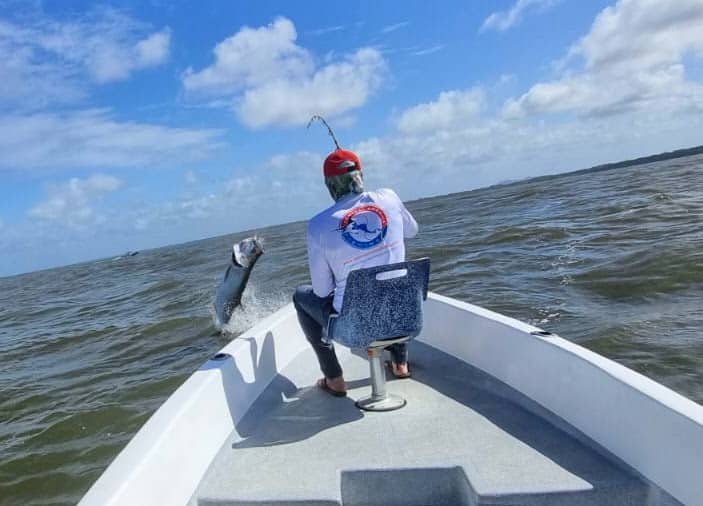
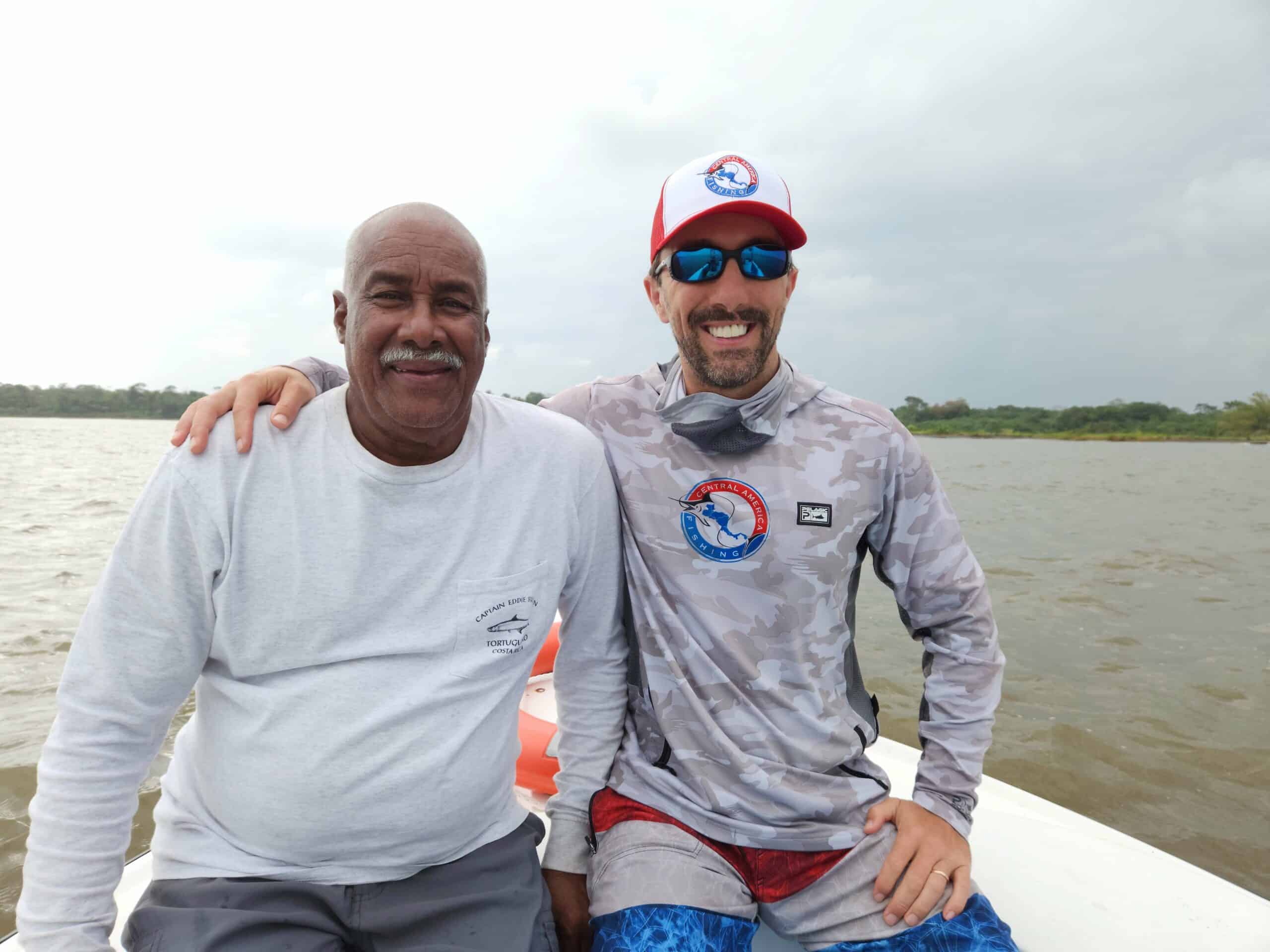
Freshwater Fishing in Costa Rica
Last but not least, if you enjoy freshwater fishing we have several different options for you here as well. The most popular is bass fishing for on Lake Arenal right in front of the iconic Arenal Volcano. The main target here is the beautiful rainbow bass, but other species include jaguar bass, machaca, and tilapia. North of Arenal we fish the exotic freshwater wetlands of the Caño Negro Wildlife Refuge. This 24,000 acre reserve is home to giants like tarpon and snook, as well as local exotics like tropical gar and bass. We also offer float trips down our jungle rivers where the main target is the hard hitting and high flying machaca. Great fun on light tackle or fly fishing, machaca are called ‘mini-tarpon’ for their high flying ability and silver scales.
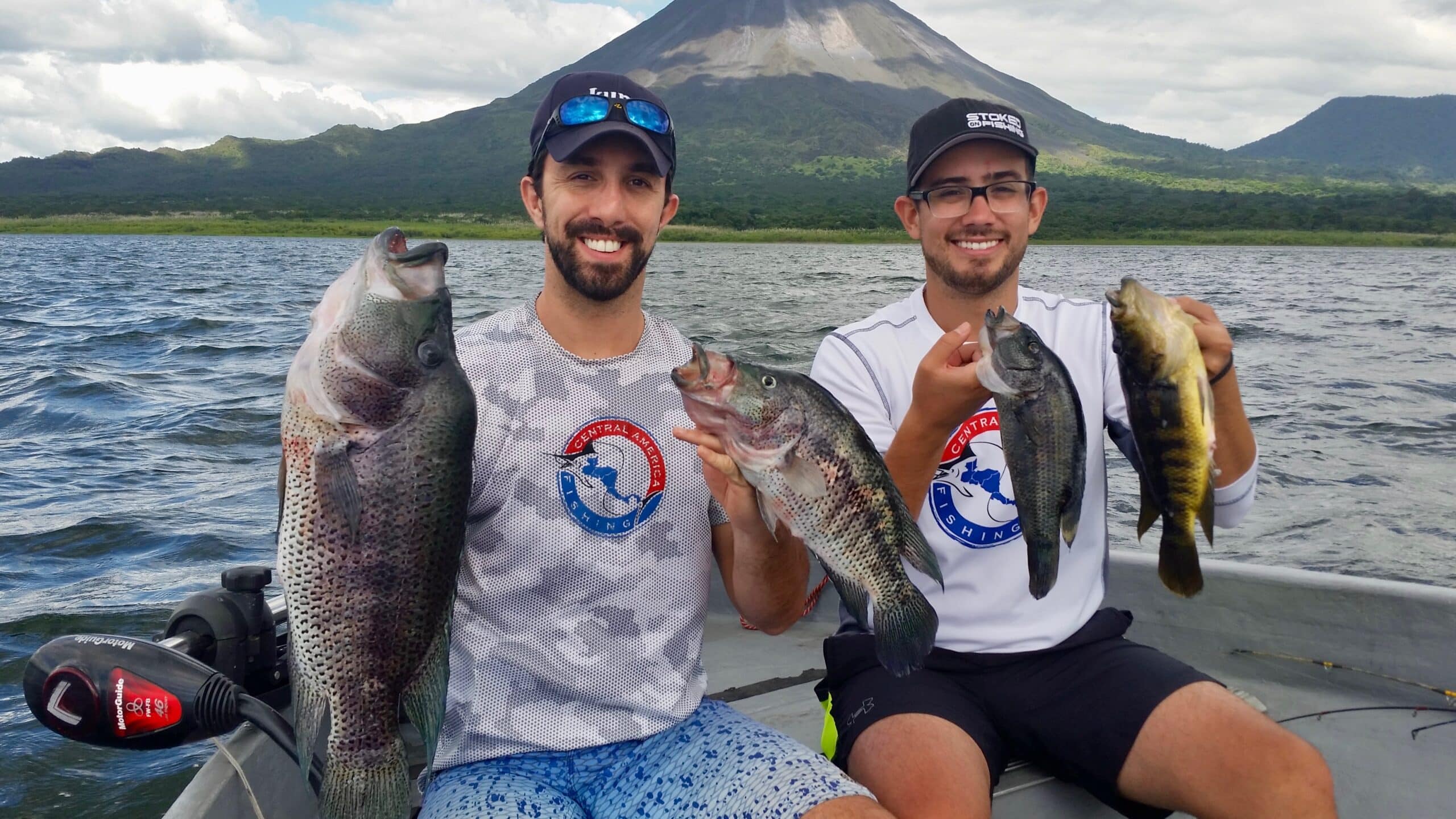
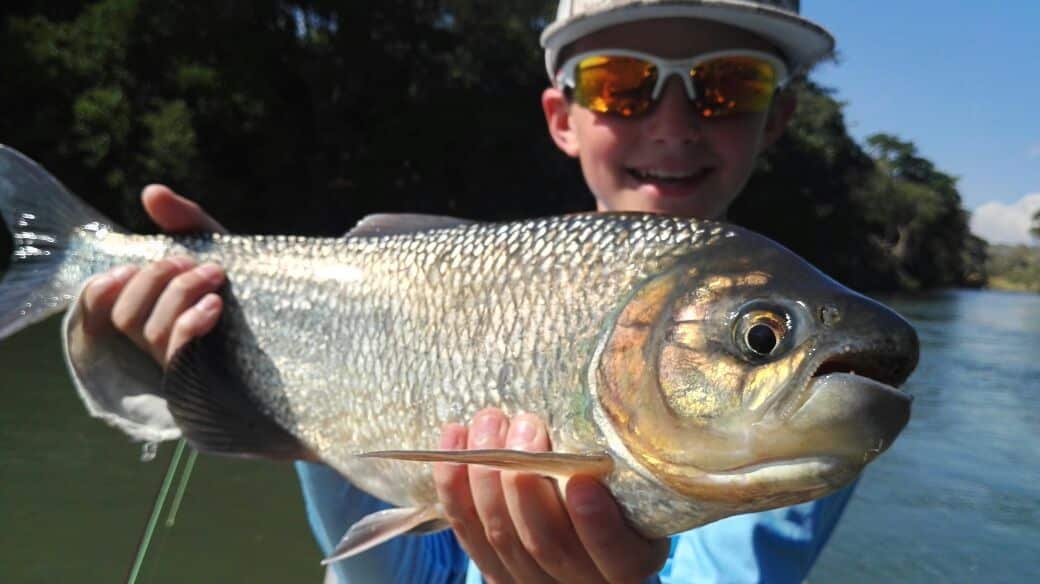
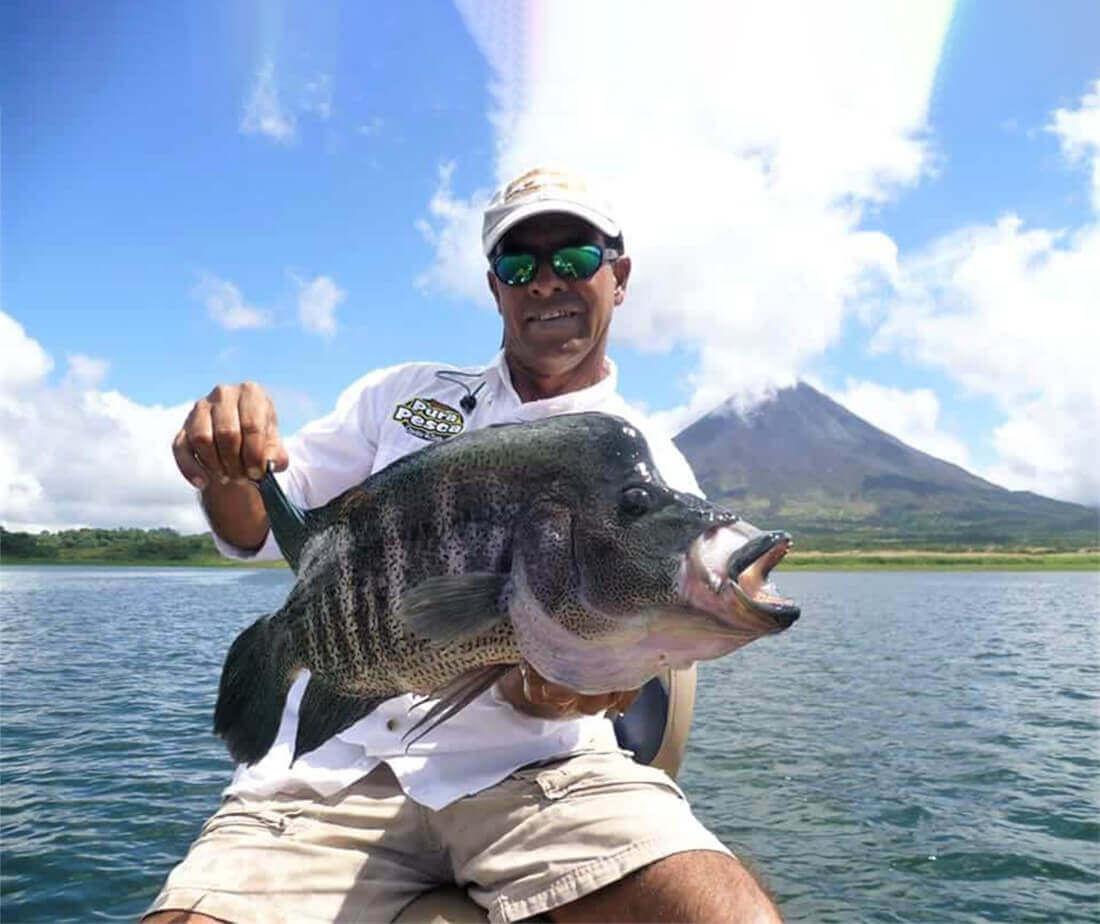
When is the Best Fishing in Costa Rica?
Knowing when to come fish Costa Rica is as important as where you fish. In addition to seasonal patterns of the game fish, Costa Rica has two main weather seasons and multiple different microclimates. The Northern Pacific has very different weather patterns than the Central & Southern Pacific, meanwhile the Caribbean Coast follows completely different weather seasons than the Pacific Coast. Some months are better for sailfish and marlin while others produce more edible fish like dorado and tuna. A lot of people spend time searching for the perfect hotel and finding the best boat, but knowing when to plan your Costa Rica fishing vacation is the most important question of all. You can read more about these details and nuances on our Costa Rica Fishing Calendar blog.
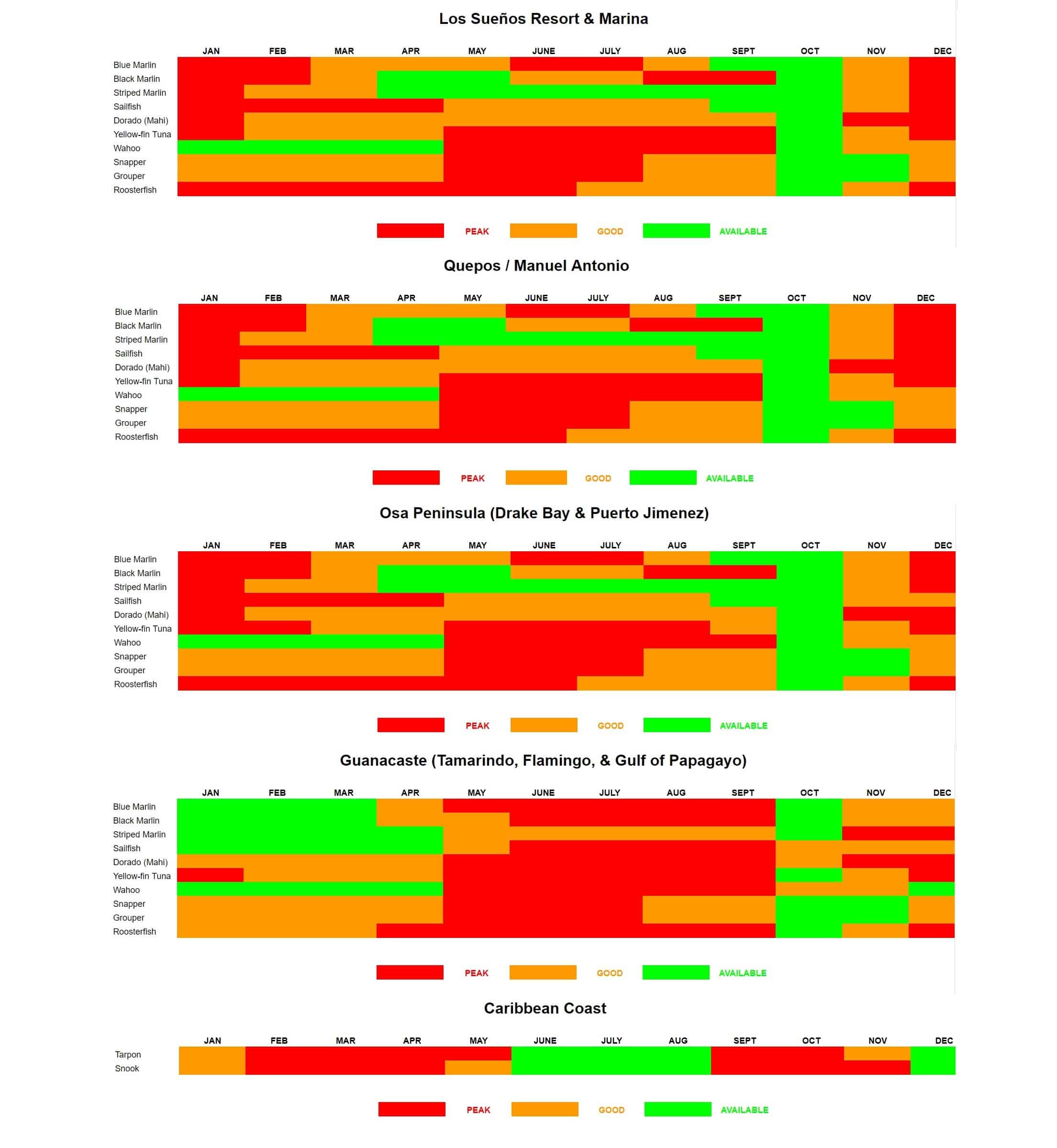
When is the Best Marlin Fishing in Costa Rica?
Costa Rica is one of the best places in the world to catch marlin. Home to blue marlin, black marlin, and striped marlin, we can literally catch them 12 months year. Striped marlin are the rarest, their peak bite is traditionally around November and December. Black marlin are the most prized, but also the most elusive. They can be caught offshore any month of the year trolling ballyhoo or live bait, but during our green season months it’s not uncommon to catch them patrolling one of our pinaccles or rock piles while targetting other species. Blue marlin are the most commonly caught species in Costa Rica. The traditional peak marlin season is December through March, but that referes to the Central & Southern Pacific. The best time to target marlin while up in the Guanacaste region is June through August.
Marlin can be caught while trolling ballyhoo for sailfish, or they can be specifically targeted by slow trolling live bait like bonito or even small yellowfin tuna. The average marlin caught in Costa Rica is 300-400 lbs, but there are a few stories of captains hooking into ‘grander’ sized fish here. Costa Rica has garnered even more fame with the overnight trips to marlin fish at the FADs, or seamounts. These two and three night trips often produce double digit marlin bites, so it’s hard to argue against the claim that Costa Rica has the best marlin fishing in the world.
When is the Best Time to Catch Sailfish in Costa Rica?
Perhaps more than any other species, sailfish is synonymous with offshore sport fishing in Costa Rica. On the bucket list for many offshore anglers, sailfish are the ultimate trophy fish due to their abundant numbers, aerial displays once hooked, and the fact they don’t require a grueling battle before they can be released. The Pacific sailfish caught in Costa Rica are larger than Atlantic sailfish, most of them in the 90-140 lb range. The peak sailfish season is December through April along Costa Rica’s Central and Southern Pacific Coast. Better evidence of this is that all of the major billfish tournaments held in Quepos and Los Suenos take place between January and April. The northern zone of Guanacaste enjoys it’s best sailfish action from May to August.
A day of sailfishing in Costa Rica typically consists of slow trolling a combination of plastic teasers and ballyhoo rigged on circle hooks. Most Costa Rican charter boats will set a spread with a plastic teaser off each side of the stern and then have a short line and a long line rigged with ballyhoo just behind and outside of the teasers. Most boats will also have a pitch bait ready in case the sailfish (or an angry marlin) comes in close or if there are multiple fish. Our higher end charter boats and will also troll dredges in an attempt to raise more fish. On good days, it’s possible to see 15-20 bites or more, including double and triple sailfish hookups. With an abundant population of billfish and predictably calm seas, Costa Rica is also one of the world’s best places to fly fish for sailfish. We have several offshore captains that specialize in offshore fly fishing.
When is the Best Yellowfin Tuna Season?
The yellowfin tuna population in Costa Rica has experienced a massive rebound thanks to the new law passed in 2018 that pushed the commercial purse sieners out to 80 miles. We used to only catch tuna during our green season months, but they were smaller fish and and we were lucky to find them. Now we find tuna literally every week, and some of the fish are growing to triple digit, trophy-sized tuna that Panama is more known for. While the months of November through March are very, very good, we literally catch tuna every month of the year now.
Tuna are most often spotted swimming with large pods of spinner dolphins, so when this happens it makes it much easier to target them while they feed at the surface. Depending on how they are feeding, tuna can be targeted by jigging cedar plugs, casting big poppers, or working swim baits. Some days the tuna are dialed in to a particular live bait, so having live bonito or blue runners (cojinua) on board can make all the difference between getting a bite or not. You are allowed to harvest tuna to bring back and enjoy for dinner, and of course our favorite – fresh sashimi right on the boat.
When is the Best Tim to Catch Dorado (Mahi-Mahi)?
Like the yellowfin tuna, the dorado population in Costa Rica has greatly benefited from the new law passed in 2018 that pushed the commercial purse seiners out to 80 miles. Not only is the population as strong as it’s ever been, the size of the fish are noticeably bigger as well. During the peak months, mature 50″- 60″ dorado are taken regularly. In fact, the dorado fishing is so good that every November the Marina Pez Vela in Quepos hosts it’s annual Dorado Derby Tournament. The peak mahi run starts in October and runs through December or January. These three months offer the biggest dorado of the year and incredible numbers. We will catch them every month of the year, but once we get into our great season months (May-Sept) we tend to see an increase in numbers but a decrease in size. The smaller dorado love to patrol the garbage lines and currents that are common during our rainy season.
Many dorado are simply caught on ballyhoo while trolling for billfish, oftentimes crashing from the side of the spread instead of from behind like a sailfish. One of the most entertaining ways to catch a dorado is when we find a floating tree that has bait hiding underneath it for shelfter, casting swimbaits or poppers can often elicit a bite from the dorado that are lurking nearby. Dorado are one of the fastest growing fish in the ocean and reach sexual maturity at just six months, which makes them an incredibly sustainable population should you have the opportunity to harvest a few that you catch.
When is Wahoo Season in Costa Rica?
The rarest of our pelagic species in Costa Rica, we tend to see the most amount of wahoo during our green season months of May to Sept. This coincides with our green season, so there tends to be more currents and trash lines offshore. While they can hit a sailfish spread at any time, we can target them by speed trolling around the various offshore reefs and pinnacles. It can be hard to land a wahoo if you aren’t rigged for them with wire leaders because their razor sharp teeth will easily cut through mono leaders.
When is the Best Tim to Catch Roosterfish in Costa Rica?
At the top of nearly everyone’s list is our famous roosterfish. Besides marlin, catching a roosterfish has to be the most popular request we hear. The good news is that Costa Rica has one of the world’s best roosterfish populations, so we’ll catch them every month of the year. They don’t seem to tolerate colder freshwater as well as other species, so the best months to catch them are during our dry season of December through April. The CAF record was set in late January 2024 when the Johson family caught 34 in one day fishing out of Quepos! Once the rains start in May, we tend to see less fish, but the ones we do see tend to be bigger in size. The start of the rainy season can be very productive as the rains will wash out the baitfish and debri in the rivers, which the roosters will happily wait around for. They do not like green water, so the months of September & October tend to be the slowest time of year.
The most common and productive way to catch roosterfish is by slow trolling live bait like blue runners or lookdowns. They can also be caught on poppers, swim baits, and sometimes even the fly. While not a law, all roosterfish in Costa Rica are catch-and-release.
When is the Best Time to Catch Snook in Costa Rica?
With two oceans, Costa Rica is actually home to several species of snook, including Pacific Snook, Common Snook, and Fat Snook. There have been mutiple IGFA world records set in Costa Rican waters for both Pacific Snook and Common Snook. The best snook fishing depends on which coast you are fishing on. On the Pacific Coast, the best snook bite is from January through April. Our good friend, Captain Roy, who has four IGFA World Records for snook, says that during the dry season they can’t access the rivers so they spend more time in the ocean where we can target them. Along the Caribbean Coast, a few world records were set in September and October for common snook. This coincides with the dry season on that coast.
The best snook fishing is often done with sardines in the river mouths and surf, which can be hard to access for many boats. The best way to fish these waters is with an experienced inshore fishing guide whose small boat can safely get you into the strike zone and then back out past the breaking waves. If you are fishing from shore, bucktail jigs cast into the surf can be very productive.
Where is the Best Fishing in Costa Rica?
Costa Rica is known to have some of the best sport fishing in the entire world, and it’s a reputation that is well deserved. The tiny Central American country is home to world class tarpon & snook fishing on it’s Caribbean Coast, numerous freshwater species in exotic locales, and of course world class inshore & offshore fishing on the Pacific Coast. The diversity of species available here, fishing venues that include two oceans along with freshwater lakes and rivers, and a 12-month fishing season make Costa Rica a fishing destination unlike any other place in the world. Below is a list of Costa Rica’s Best Fishing Destinations so you know where to go, and when, on your next fishing vacation to Costa Rica.
Fishing on Costa Rica’s Pacific Coast
When people in the fishing world refer to Costa Rica as the “billfish capital of the world”, they are referring to the phenomenal marlin and sailfish action found on our Pacific Coast. World famous hot spots like the Los Sueños Resort & Marina and the Marina Pez Vela in Quepos are home to some of the best captains and fishing boats in Central America, not to mention major international billfish tournaments. It doesn’t end there however as prolific sport fishing can be enjoyed from the northern Pacific region of Guanacaste in places like Tamarindo, Flamingo, and the Gulf of Papagayo all the way to the exotic Osa Peninsula in the south Pacific where you’ll find Golfito and Drake Bay. While offshore fishing for triple-digit sized billfish may dominate magazine covers and advertisements, it goes without saying that the mighty roosterfish is one of the most targeted and asked about species by our anglers. So the majority of the time when people ask, ‘Where is the best fishing in Costa Rica?‘, the answer is the Pacific Coast due to predictable weather patterns and sea conditions, modern marinas, fantastic beach towns with tons hotels & private rentalsto choose from, and of course amazing inshore and offshore fishing.
Weather on Costa Rica’s Pacific Coast
The weather on Costa Rica’s Pacific Coast is about as predictable as weather can get. From December through April it’s the dry season, or summer, where you will all but be guaranteed hot and sunny weather. During these months the Guanacaste region in the north can (and usually does) get very strong winds so the fishing is better in the central and southern regions of the country like Los Suenos and Manuel Antonio. During the months of May-November we experience our green season where afternoon rain showers are common. The wettest month of the year is October, but even then the fishing still productive and most days are hot and sunny until 2-3 PM.
Boat Selection
Along Costa Rica’s Pacific Coast, you’ll find a seemingly infinite number of boats to fit any size and any budget. You’ll also find several state-of-the-art, first-class international marinas like the Los Sueños Marina, the Marina Pez Vela in Quepos, Papagayo Marina, and the new marinas in Golfito and Playa Flamingo. Most inshore boats are 26′-28′ pangas or center consoles while the most common offshore boat is a 28′-32′ sport fisher with a cabin and tower. For the more hardcore or discerning angler, our tournament-class boats in the 38′-45′ range are as good as they get in Central America. For large groups of 6-10 anglers, we also have 50′-60′ yachts with multiple state rooms and air-conditioned salons with kitchens and TVs. With multiple marinas and fishing towns dotted along the coast you’ll find any make of boat you’ve ever heard of – Bertram, Hatteras, Topaz, Contender, Mako, Cabo, Viking, and of course Costa Rica’s own Maverick Yachts.
Hotel Selection
Without any question, the best beach hotels, all-inclusive resorts, and fishing lodges are located on Costa Rica’s Pacific Coast. From boutique adults-only hotels to large family-friendly all-inclusive resorts, a private bungalow or a private villa, an eco-lodge or a fishing-lodge, you’ll have no trouble finding the perfect accommodation for your fishing trip to Costa Rica.
Beaches & Towns
Costa Rica’s most popular and well-known beach towns are also located along the Pacific Coast. The party & surf town of Jaco is just 75 minutes outside of San Jose while the international hot spot of Manuel Antonio is just 2.5 hrs away. If you are in Guanacaste you’ll find Tamarindo, Flamingo, Playa Hermosa, and Carillo as major hubs for entertainment and accommodations. These beaches are also the most picturesque and swimmable in Costa Rica, so it’s certainly no coincidence that the biggest and best hotels were developed here. All of these beach towns offer a great selection of local restaurants, bars, grocery stores, banks, ATMS and hospitals or clinics.
Other Tours
At just about any major beach town along Costa Rica’s Pacific Coast you’ll have a menagerie of eco and adventure tours to choose from. Eco tours can include guided tours of national parks, kayaking or boating through complex mangrove systems, whale watching, turtle watching, or sunset catamaran cruise. If it wasn’t for sport fishing in Costa Rica, the adventure tours would certainly be the claim to fame as options like the canopy zip-line, white water rafting, ATVs, horseback riding, surfing, golf, snorkeling & diving, and even waterfall rappelling can be found in most destinations. Whether you need a day off from fishing or are vacationing with family, you’ll find plenty to do here on your non-fishing days.
Fishing on Costa Rica’s Caribbean Coast
When most people envision the Caribbean Coast of a Central American country, they picture something from a Corona commercial with sugar-white sand beaches, clear turquoise water, and calm waves lapping at the shoreline. While this can be true in some beaches along Costa Rica’s Southern Caribbean Coast, it’s not what you should expect on your fishing trip. When trying to decide where to fish in Costa Rica: Pacific vs Caribbean, you need to consider what you’ll want to do on any non-fishing days or if members of your group don’t fish because the Northern Caribbean is not a ‘beach’ destination. Unlike other destinations like Belize or the Yucatan Peninsula that are protected by the Mesoamerican Reef, Costa Rica’s Northern Caribbean Coast is open water so it can be very rough and generally has a lot of currents. The beaches in this part of the country tend to be black sand and are part of the massive conservation area, so there isn’t a lot of infrastructure out here.
That said, if you are coming to fish Costa Rica’s Atlantic Coast offers some of the best snook and tarpon fishing in the entire world – as is evidence by the various IGFA world records set here. While you are cruising the coastline or fishing the river mouths you can also come across jacks, snapper, grouper, mackerel, barracuda and even the occasional shark. If you want a day of light tackle adventure you can head into the freshwater lagoons and rivers and fish for a variety of local species like rainbow bass (guapote), machaca, mojarra (blue gill), and the prehistoric tropical gar. Costa Rica’s Caribbean Coast is as beautiful as it gets, but it’s not a spot for beach-bums as the combination of strong currents, waves, sharks, and crocodiles make this an exotic fishing destination rather than a Caribbean beach vacay.
Weather on Costa Rica’s Caribbean Coast
As with anywhere in the Caribbean, the weather on Costa Rica’s Atlantic Coast is about as unpredictable as it gets. Despite being just 180 miles wide at its widest point, the weather on the Caribbean Coast in Costa Rica is vastly different from the Pacific Coast. The drier summer months on the Caribbean are January through mid-May when showers are least common and seas conditions are optimal for fishing. They also experience a two-month dry season in September and October, which are the wettest months of the year on the Pacific Coast. The months of mid-May to August and then November through early January tend to be very stormy and rainy, so fishing isn’t advised for these periods.
Boat Selection
Along Costa Rica’s Caribbean Coast, you won’t find marinas or a bay full of moorings, this is the land of pangas and center consoles. The panga, or super panga, rose to fame as a top inshore fishing boat in the Caribbean for it’s ability to punch through waves, run into shallow water, and flat out for its affordability. If you aren’t fishing in a panga you’ll be fishing in something close to it as all of the top tarpon guides and tarpon lodges here use 26′ deep-V center consoles to be able to get through the river mouth safely and offer 360-degree fishability. If you spend a day fishing the freshwater canals or rivers you can also use a small skiff or Jon-boat that can take you deep into the jungle.
Hotel Selection
Costa Rica’s Caribbean Coast does not offer anywhere near the amount of beach towns or hotel selections as the Pacific Coast. By far the least developed of the two coasts, your options here are eco-lodges, tarpon fishing lodges, and a handful of luxury hotels. Many people incorrectly assume that Costa Rica features a white sand and turquoise blue Caribbean scene like Belize or Mexico, but here it’s not like that so all the major developments and hotels will be found on the Pacific.
Beaches & Towns
The southern Caribbean Coast of Costa Rica does feature some gorgeous, postcard-esque beaches like Cahuita, Puerto Viejo, and Cocles. Often more of a draw for backpackers or beachgoers, if you love the Caribbean vibe of rastas, Bob Marley music playing at every bar, and eating ‘rice and beans’ you’ll love it here. The northern Caribbean Coast of Costa Rica takes on a much different, eco-friendly vibe than it’s more libation-friendly southern region. Much of this can be attributed to the 400,000 acre Barra de Colorado Wildlife Refuge. Without doubt the largest tourist town here, consisting of about 900 locals, is the world-famous sea turtle nesting site of Tortuguero. The major port town on this coast, Limon, is where the cruise ships and container ships dock but due to safety issues and lack of quality beaches we highly recommend you don’t spend any time here.
Other Tours
Along the Caribbean Coast you won’t find the laundry list of tours available to you that you would on the Pacific, but if you love nature this may be paradise. Eco tours available are guided tours of national parks, kayaking, snorkeling, bird watching, animal sanctuaries, and of course turtle viewing. Depending on the month you visit you can see four different species of turtles either laying their eggs or hatching here – but you MUST go with a guide as this is a national park and very protected.
The Top Six Places to Fish in Costa Rica
Los Sueños Resort & Marina
First on our list of Costa Rica’s Best Fishing Destinations has to be the famous Los Sueños Resort & Marina. Los Sueños opened in 2001 and is the crown jewel when it comes to sport fishing in Costa Rica. Nestled in Herradura Bay along Costa Rica’s Central Pacific Coast, it is located just over one hour from the SJO International Airport. This 1,100 acre property features an 18-hole golf course, a 600-acre nature reserve, a beautiful beach club, a marina village with boutique shops, a spa, and grocery & liquor stores, six restaurants, and finally over 500 private residences and luxury condos. These privately owned 1, 2, and 3 bedroom condos and the luxury vacation villas make Los Sueños the ideal location for your next fishing vacation to Costa Rica.

Quepos / Manuel Antonio
An hour south of the Los Sueños Resort you’ll find one of the most prolific fishing destinations in Costa Rica, Quepos. Traditionally known as the ‘fishing capital of Costa Rica’, Quepos was the place to go in the 80’s and 90’s before the modern Los Sueños Resort & Marina was opened in 2001. Not to be left behind, in 2012 Quepos finally opened it’s brand new Marina Pez Vela and instantly proved stiff competition to the Los Sueños Marina. The gorgeous new marina offers 195 wet slips, restaurants, bars, boutique shops and a more family-friendly approach with movies shown outdoor at night in their amphitheater. Also home to the famous Manuel Antonio National Park, this area is the quintessential destination for first time visitors to Costa Rica as it offers beaches, rain forest, wildlife, luxury hotels, and of course great sport fishing.

Guanacaste (Tamarindo, Flamingo, Gulf of Papagayo)
Northeast Caribbean Coast (Rio Colorado, Rio Parismina, Tortuguero)
Switching coasts and fisheries, one has to mention the Caribbean Coast when they talk about sport fishing in Costa Rica. The tarpon fishing is some of the best in the world as these are all big, mature fish we find here. Here 80-100 lb tarpon are the norm and every year we jump (and sometimes land) 150-200 lb behemoths. Most of the tarpon fishing is done in river mouths and within a mile or two of the shore as giant rivers like the Rio Colorado, Rio Parismina, and Rio Tortuguero create the perfect environment for tarpon to chase their prey in the saltwater of the ocean, the brackish water of the river mouths, or the freshwater in the canals and lagoons. We mainly fish for tarpon with bucktail jigs and sardines in the ocean, but in the river mouths rapalas elicit plenty of bites but the treble hooks don’t always survive.
Costa Rica’s Caribbean Coast has an entirely different weather pattern than the Pacific Coast so knowing when to come fish is important. The tarpon in Costa Rica are not highly migratory like they are throughout much of the rest of the Caribbean, they are always here, but some months the weather can be miserable and the river mouths can simply be too dangerous to cross so you’ll be stick fishing the freshwater canals all day. There are two tarpon seasons on Costa Rica’s Caribbean Coast, mid-Jan to mid-May and then again in September & October.

Lake Arenal
For the fishing savants out there, fear not, Costa Rica isn’t all about big game fishing for billfish, tuna, and tarpon. The mountains and lush rain forest provide several freshwater fishing opportunities on our various lakes and rivers. The biggest of them all is the 33-acre Lake Arenal, which provides a gorgeous setting for exciting fresh water fishing for species like machaca, tilapia, and the prized rainbow bass. This man-made lake, formed in 1979 to produce cheap hydroelectric power for the region, contains endless pockets, fingers, and river mouths that provide habitat for these fresh water species.
Machaca have earned the nickname “mini tarpon” for their acrobatic jumps while rainbow bass are one of the hardest fighting freshwater species you can find. Whether you are casting plugs and crank baits, fly fishing, or trolling deeper water for the big rainbow bass it’s hard to beat the bite and the beautiful scenery. Few things will compare to an early morning on a glass-flat lake in front of the imposing Arenal Volcano with the sound of howler monkeys waking up.
Besides bass fishing on the lake, Costa Rica also offers float trips down some of her pristine jungle rivers. This is available in various parts of the country, so depending on where your vacation takes you or what time of year you visit will determine which river is best for you. The float trips are a unique and memorable way to spend the day since it’s just you and your guide in the raft as you float through the Costa Rican rainforest – often times with no one else in site. This essentially combines two tours into one as you’ll fish and get to enjoy some incredible wildlife viewing of birds, monkeys, sloths, and yes even crocodiles (don’t worry, they are friendly here!). Whether fly fishing or light tackle spin fishing, you’ll make countless casts towards the river banks as you slowly float down the Class I-II rapids trying to elicit a strike from the ever-aggressive machaca. You can also catch small snook, snapper, rainbow bass, and a few other exotic freshwater species on the river trips.
Osa Peninsula (Drake Bay, Puerto Jimenez, Golfito)
Last but not least on our list of Costa Rica’s Best Fishing Destinations is the final frontier, the Osa Peninsula. Comprised almost entirely by the 164 sq mile Corcovado National Park, Costa Rica’s most prized national park, National Geographic has referred to the Osa Peninsula as ‘the most biologically intense place on Earth.‘ The wildlife here is almost unparalleled anywhere else on the planet as you’ll find 5% of the entire world’s biodiversity right here including hundreds of species of birds, some of the most venomous snakes in the world, crocodiles, and mammals big and small including tapir, jaguars, pumas, ocelots, four species of monkeys and sloths. The best way to get to the Osa Peninsula is to take a 50-minute domestic flight from San Jose or to take an hour long boat ride from the town of Sierpe if you find yourself already in southern Costa Rica.

The combination of little human influence, abundant marine life, and fewer sport fishing boats than any other spot on this list of Costa Rica’s Best Fishing Destinations make fishing in the Osa Peninsula an exciting venture. Over 40 IGFA records have been set within 80 nautical miles, and it could probably be even more if there were more boats fishing these waters. Marlin and sailfish are found offshore as well as great numbers of yellowfin tuna. The numerous reefs and pinnacles make for some of the best dive sites in the country, as well as what is arguably the best fishing for giant cubera snapper. If you want nightlife and luxury resorts you can look elsewhere, but if you are looking for incredible nature and plenty of fish that can bend your rod, we suggest you try the Osa Peninsula out on your next fishing trip to Costa Rica.
Available Species in Costa Rica
Costa Rica has rightly earned the nickname ‘the billfish capital of the world‘ thanks to its incredible 12-month fishery for sailfish and marlin. As if having the world’s best billfishing wasn’t enough, Costa Rica offers amazing fishing options pretty much anywhere you turn. The offshore sport fishing on the Pacific also offers a fantastic – an improving – yellow-fin tuna bite, dorado, and wahoo. Inshore fishing is where you’ll find the most variety with up to twenty species of game fish, including of course the ever-popular roosterfish and cubera snapper. On the other side of the country, Costa Rica offers some of the world’s best tarpon and snook fishing as several IGFA world records have been caught here. Last but not least, our rivers and lakes provide excellent freshwater fishing for local exotic fish like rainbow bass, machaca, and tropical gar. No matter where your Costa Rica fishing vacation takes you, rest assured you won’t be far from catching some amazing species!
Offshore Fishing
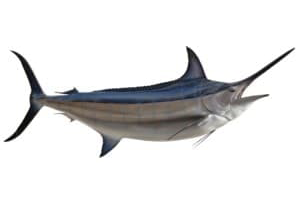
Black Marlin
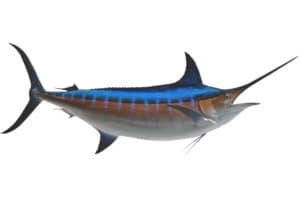
Blue Marlin
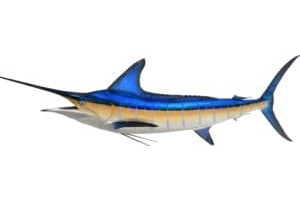
Striped Marlin

Sailfish
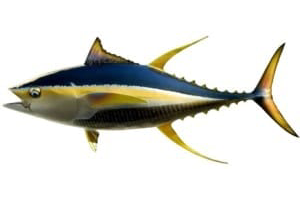
Yellowfin Tuna
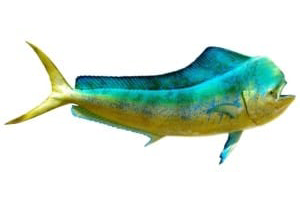
Dorado
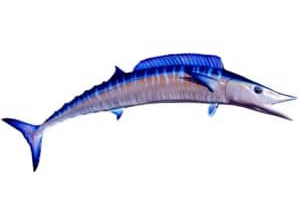
Wahoo
Inshore & Bottom Fishing
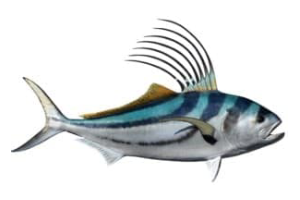
Roosterfish
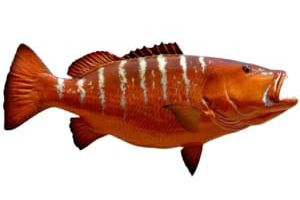
Cubera Snapper
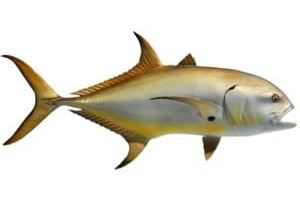
Jack Crevalle
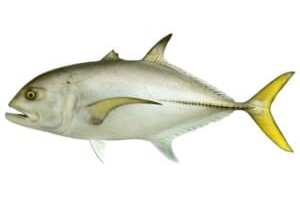
Horse-eye Jack
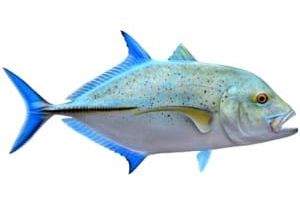
Bluefin Trevally
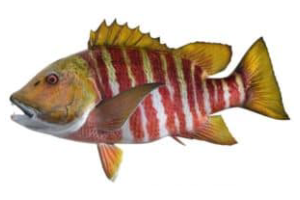
Rock Snapper
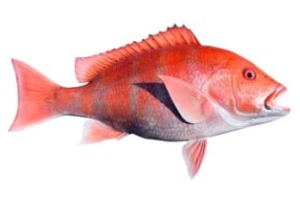
Red Snapper
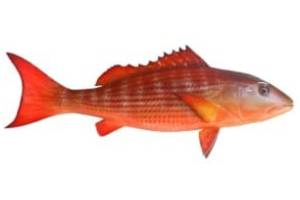
Mullet Snapper
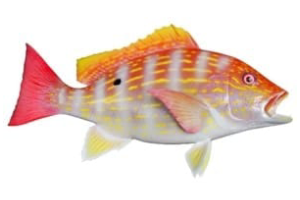
Lane Snapper
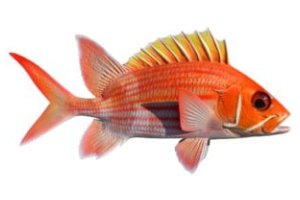
Squirrelfish
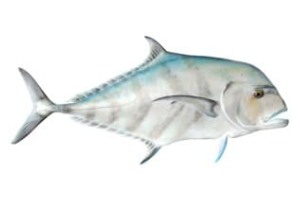
African Pompano
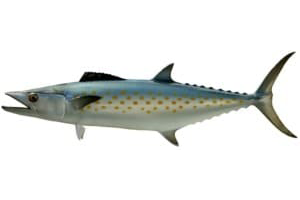
Mackerel
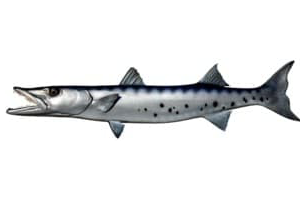
Barracuda
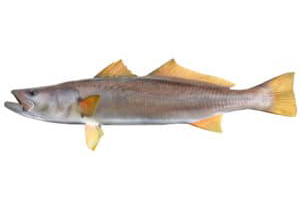
Corvina
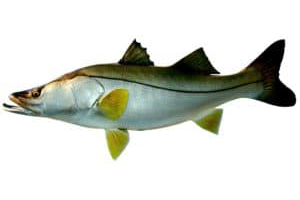
Pacific Snook
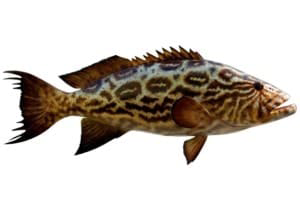
Broomtail Grouper
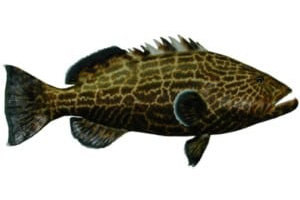
Black Grouper
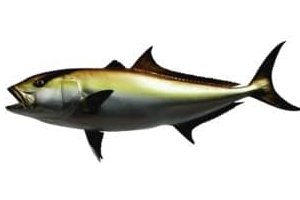
Amberjack
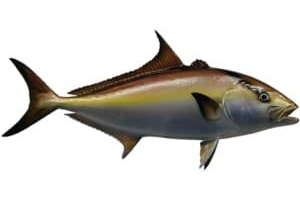
Almaco Jack
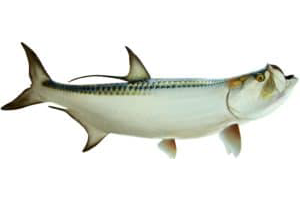
Tarpon
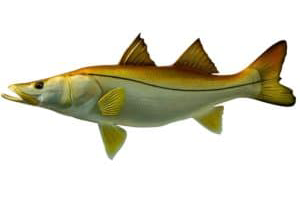
Snook
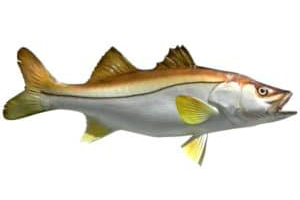
Fat Snook
Freshwater Fishing
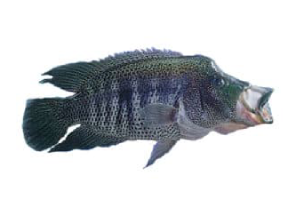
Rainbow Bass
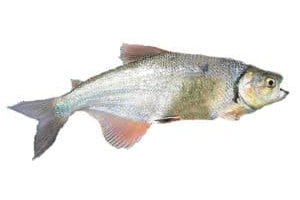
Machaca
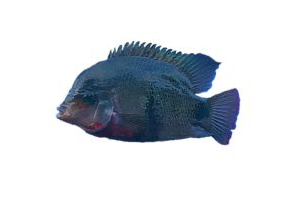
Mojarra
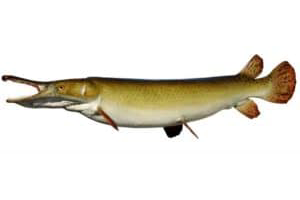
Tropical Gar
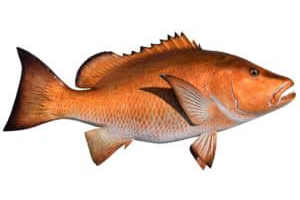
Mangrove Snapper
Costa Rica Fishing Charters
Costa Rica has been blessed with an incredible fishery, both salwater and freshwater, but it wouldn’t have developed into the sport fishing powerhouse that it is without all the incredible captains that work on these waters year after year. From local captains who fish in their hometowns to captains who came down from the US decades ago, some of the best captains in the industry call Costa Rica home.
How To Pick a Charter Boat
When you begin planning your Costa Rica fishing vacation, one of the biggest decisions you’ll make is which boat you fish on. It’s likely one of the biggest expenses of your trip, plus the one that will either create the most memories or be blamed for being the biggest disappointment of your week. First, you’ll need to decide what size boat you need. We generally have three classes of sport fishing boats here:
Small (25′-30′) – Our small boats are ideal for 1-3 anglers and can usually only take 4 people max. While some of these can go offshore, these smaller boats are often the best inshore fishing boats in the country.
Medium (31′-34′) – Our medium-sized boats are the most popular sized charter boats in Costa Rica as they are affordable for two anglers but can fit larger groups of 4-5 anglers. These boats tend to have towers, shaded seating, and cabins with bathrooms.
Large (35′-45′) – Our larger sized charter boats in Costa Rica tend to be our tournament-quality boats. Bigger and faster, these boats will come with an air-conditioned salon and usually slightly upgraded technology and fishing tackle versus the more budget-friendly smaller charter boats. These are great for groups of 4-8 anglers who want a bit more space, luxury, and speed.
Extra Large (46′-58′) – For our larger groups or our hardcore discerning anglers, we have a few luxury sport fishing yachts that offer a 5-star experience. These boats will all have air-conditioned salons, state rooms, kitchens, and some even with TVs or satellite internet. These extra-large boats can fit 8-10 anglers.
Once you determine what size boat your group needs, you’ll need to find a quality captain and reputable charter operation. There are no shortage of horror stories every year of anglers who book one boat online but are given a different boat the day they show up to the marina, and that still happens today sadly. Some sites have tried to make booking a charter boat a similar experience to booking a hotel, but it’s not that easy. The best captains start to fill up 10-12 months in advance with repeat clients, so you won’t find them listed with online booking sites. Reviews from travelers can also be misleading, as a great boat could have bad reviews because their clients thought they were guaranteed flat seas and marlin every day. The only way to be sure is to trust someone like Central America Fishing who lives here, fishes here, and hand picks every charter boat that we partner with.
Picking Your Captain
Here in Costa Rica, you can choose between local captains or American captains, and both bring their own pros & cons. Matching up your group’s fishing goals and personalities to the right captain is something that we do on every trip since we know them all personally. Some captains are hyper competitive, some are laid back and quiet, and some are very social and love to interact with you. Catching fish is important, but so is enjoying your crew since you’ll be spending 8-9 hours each day with them!
Maverick Yachts
We are proud to be one of the select few preferred partners of the famous Maverick Yachts. Based out of the Los Suenos Resort & Marina, these are some of the nicest sport fishing charter boats in all of Central America. Central America Fishing gives our anglers access to the best captains and the best rates with this esteemed charter operation.
Costa Rica Fishing Lodges & Accommodations
Costa Rica has been attracting foreign tourists for decades, so there is no shortage of quality accommodations for your next fishing vacation. The options we have for you include exclusive boutique hotels, luxury beach resorts, exotic eco-lodges, all-inclusive fishing lodges, and even fully furnished private condos & villas for larger groups or families. After twenty years of experience living and working right here in Costa Rica, we’ve literally hand-picked the properties that we partner with to ensure that our guests receive the best service and have the best experience possible. With our vast network of partner hotel & resorts, we consider various factors like your travel style, purpose of the trip, desired amenities and activities on non-fishing days, and of course your budget to hand-pick the right fit for you. Being local experts, we have personally visited every single property we represent so we’ll use our personal experience to hand pick the perfect fit for your group on your Costa Rica fishing vacation.
Hotels & Resorts
It is estimated that 80% of the hotels in Costa Rica are boutique hotels of 40 rooms or less, and in our experience, these tend to offer the best service and the most authentic Costa Rican experience. Many of these hotels include breakfast with your stay, which means you are free to explore your beach town and try out various local restaurants for dinner each night. We of course can give recommendations for our personal favorites and even assist with making reservations for you. As a luxury agency that only works with higher end 4-5 star properties, a quality 4-star hotel can be in the range of $200-$300 per night while our most exclusive 5-star properties can be as much as $700-$1,000 per night. The best boutique hotels in Costa Rica are some of the most popular hotels in the entire country, so they do fill up months in advnance.
All Inclusive Resorts
Unlike other Caribbean destinations that only offer all-inclusive resorts, Costa Rica was never developed to be an all-inclusive destination. A large reason why is because it is so safe, you can drink the water, and you can eat at local restaurants so that model of tourism was never necessary like it is in less-developed vacation hotspots. That said, Costa Rica does still offer a handful of all-inclusive resorts for guests to enjoy. These are all located in the Northern Pacific region of Costa Rica known as Guanacaste. This is the most developed and touristy region of Costa Rica, also referred to as the “Gold Coast’, due to its golden sand beaches and year-round sunny weather. When picking an all-inclusive resort in Costa Rica, it’s important to not get lured in by a cheap online offer or a heavily edited photo because some of the properties label themselves as 5-stars, but the experience once you are here is much more aligned with a 3-star resort. We have a select few all-inclusive resorts that we prefer for our guests, but the majority aren’t worth it.
Fishing Lodges
With a sport fishing industry that has been popular for of forty years, Costa Rica is home to some iconic fishing lodges. On the Caribbean Coast, famous tarpon lodges like the Silver King Lodge and the Rio Parismina Lodge have been around for forty years. On the Pacific Coast we have the former Crocodile Bay Resort and the exclusive Zancudo Lodge, our #1 rated fishing lodge in Costa Rica. Fishing lodges were necessary on the Caribbean Coast because of how isolated and remote it is, but on the Pacific Coast building an all inclusive fishing lodge wasn’t as needed because the major beachtowns already offered hotels and condos. These are great for anglers who want everything included and only want to come to Costa Rica and fish.
Private Villas & Condos
For larger groups and families, Costa Rica also offers private condos and villas to rent. The most popular beach towns offer a wide variety of villas ranging from 3-bedrooms to 10-bedrooms and from the quaint to the ultra luxury. Most of our luxury villas include maid service and a concierge. Many beach towns also offers properties and resorts that have private 1-bedroom, 2-bedroom, and 3-bedroom condos to rent. These are great for smaller groups and for bachelor groups where everyone wants their own room. When you stay at a private rental you can decide to shop and cook for yourselves, eat at local restaurants, or we can set you up with a private chef for breakfast and/or dinner.
Can I Stay at an Airbnb in Costa Rica?
Yes. Over the past decade, Airbnbs in Costa Rica have become a viable option for a quality, if not luxurious, vacation experience. From the Manuel Antonio/Quepos area up to Guancaste, we have partner with a range of budget-friendly 1 & 2 bedroom condos up to luxury private villas that are all listed on Airbnb. We are able to do this because we are here in Costa Rica, so we personally know the owners or the property managers of the Airbnb’s that we offer and have visited them all ourselves. Best of all, if you book one of our parnter properties that is listed on Airbnb as well it costs you the exact same as booking it online by yourself.
Costa Rica Day Tours & Excursions
Our Costa Rica fishing packages don’t need to be all fishing, all the time. Costa Rica is of course just as famous for its volcanoes, rain forest, beaches and incredible wildlife as it is sport fishing. Whether it’s an off day from fishing or for the non-anglers in your group, there are several great eco and adventure tours available. We can also customize your Costa Rica fishing vacation so you spend a few nights in different locations throughout the country so you can see how diverse it is. The list includes:
- Canopy zip-line tour
- White Water Rafting
- Waterfall rappelling
- ATVs
- Horseback Riding (beach or rainforest)
- Surfing
- Golf
- Guided tours of national parks
- Waterfalls
- Thermal hot springs
- Sunset catamaran cruise
- Snorkeling
- SCUBA Diving
- Kayaking
- Jet Skis
- Parasailing
- Coffee plantation tour
How Much Does it Cost to Fish in Costa Rica?
Generally speaking, a full day of offshore fishing will cost $1,000-$1,500 on a quality 30′-34′ boat while larger 36′-42′ boats with air conditioned cabins can cost up to $1,800-$2,500. Our largest 50′-60′ luxury yachts can cost over $3,000 for a full day. Inshore fishing is generally more affordable as it’s done on smaller boats that burn less gas. A full day of inshore fishing can cost between $600-$800 while a half day can be found for $400-$600.
The final total cost of a Costa Rica fishing vacation, with all transfer/hotels/tour included, depends on numerous factors, such as:
- How many nights you stay
- Which hotel/resort/lodge you stay at
- The room category you choose at the property
- The number of people per room
- The number of people fishing on the boat
- How many days you fish
- The size of the boat you fish on
- The time of year you visit
Costa Rica Fishing FAQs
Do I need a fishing license to fish in Costa Rica?
YES. All anglers need a fishing license to fish in Costa Rica. These are sold by the Instituto Costarricense de Pesca y Aquacultura, or INCOPESCA as they are known here. Unfortunately their website has functionality and language issues so it’s not easy to use, so you can buy the license in the morning right before you fish for the first time. The cost is $15 for one week or $30 for one month and it must be paid in cash.
How many people will be on my fishing boat?
All fishing charters booked by Central America Fishing are private, so the boat is 100% yours. We do not set up any shared charters.
What is the standard tip for a fishing charter in Costa Rica?
A standard tip for a charter fishing crew in Costa Rica is 10%-20% of the cost of the charter. Most captains are paid a low salary with the idea they’ll earn more tips the more they fish, but many mates rely 100% on tips for their income. Tipping in USD or Costa Rican colones is fine. We recommend giving the entire tip to the captain and let him divide it up with the mate.
Can I bring my own fishing gear?
OF COURSE! Even though our private charters provide all the fishing tackle and bait you’ll need, you are always welcome to bring your own lures, reels, and even rods if you want to catch fish using your own tackle. Fly anglers are always encouraged to bring their own fly gear.
Which fish in Costa Rica are catch and release and which ones can I keep to eat?
By law, all billfish in Costa Rica are strictly catch and release. While not a law, we also strongly encourage releasing all roosterfish, tarpon, and cubera snapper as they are such prized inshore species. Other species like tuna, dorado (mahi), wahoo, snappers, groupers, corvina, snook can be kept and enjoyed for a fresh seafood dinner.
Can I bring fish back home with me to my own country?
If you really want to enjoy your catch our best advice is to eat it while it’s fresh here in Costa Rica. We understand many of you love the idea of a Costa Rican seafood dinner in the comforts of your own home, so the good news is there is no law against it and people do it all the time. However – we do not have the final say in this so there are some things you need to keep in mind:
1 – Unlike some other popular fishing destinations, in Costa Rica there is no service that will package and ship fish home for you. If you want to bring fish home with you you’ll have to do it yourself in your own luggage. Our best advice is to bring down a soft sided, leak-proof cooler, have your fish frozen completely solid, wrap them in newspaper, and then check your cooler as part of your luggage since it will stay cooler in the cargo hold of the plane versus in the cabin as a carry-on. If you don’t have a cooler or forget to bring one, you can purchase affordable plastic coolers here in local grocery stores.
2 – While Costa Rica does not prohibit you from bringing fish fillets home with you, your international airline might. We strongly recommend you confirm this with your airline (in writing if possible) or you may have the fish confiscated from you at the airport check-in.
3 – Even if your airline lets you fly the fish home, your local customs may have an issue with you bringing in meat products from a foreign country. In our experience most customs agents don’t seem too interested in you bringing back frozen fish fillets from your fishing vacation to Costa Rica, but it can depend on the agent and depend on the day.
What if there is bad weather on our fishing day?
First of all, it is extremely rare to have a fishing day cancelled due to bad weather. Costa Rica is too far south for hurricanes, and on top of that we custom design every single one of our Costa Rica fishing packages to factor in not only where you’ll have the best fishing but also the best weather & sea conditions for the time of year you visit us.
It does happen every once in a while however, so if the captain, local marina, or government deem the conditions are unsafe the trip will be cancelled. The first course of action is to try and reschedule you, but if that is not possible you will be refunded in full.
Please note that rain and dark clouds are not considered bad weather. We are in the tropics and rain is a common occurrence here so that is not a cause for cancelling the trip. Many great fishing days happen in the rain – as they say the fish are wet anyway!
What Our Guests Love
About Fishing in Costa Rica
One of the most common themes we hear in our client reviews are how friendly and inviting the locals are. Costa Ricans are very proud of their country, and they are eager to share it with international visitors.
Honing their craft for decades, Costa Rica is home to some of the best fishing captains & crews in Central America. Most of our destinations offer a good mix of American and local Costa Rican captains, so we’ll hand-pick the right fit for your group and fishing style.
Costa Rica wouldn’t be such a popular sport fishing destination if it didn’t produce results, which it has for the past 40+ years. Even if the bite is off for your target species, there is always something to catch here so our guests rarely leave empty handed.
Our guests love that a fishing vacation to Costa Rica doesn’t need to be 100% fishing. There is so much to experience and see here, the majority of our guests take time off from fishing to enjoy the natural highlights like the various national parks, the Arenal Volcano & hot springs, wildlife viewing, world class 18-hole golf courses, and of course just some down time at the beach and hotel pools.
What We Love
About Fishing in Costa Rica
Costa Rica truly offers something for everyone. Hardcore anglers can fish every single day at world class fishing lodges like Zancudo Lodge & the Los Suenos Resort, but it’s a great spot for families, honeymoons, and mixed group trips too. With beaches, rainforest, wildlife, adventure tours, golf courses, spas, and charming small beach towns, there is something to do no matter what your interests are.
The diversity of the fishery in Costa Rica. Home to some of the world’s best offshore fishing, Costa Rica’s Pacific Coast also offers incredible inshore fishing for popular trophies like roosterfish, snapper, and world record sized snook. The Caribbean Coast features amazing fishing for tarpon and snook We even offer freshwater fishing on our lakes and rivers. Best of all, it’s actually possible to fit ALL of that in during the same trip!
Options galore. Tourists have been visiting Costa Rica since the 1980’s, so we have a range of accommodations to fit almost any group size and budget. From boutique hotels to all-inclusive resorts, from affordable Airbnb’s to exclusive private villas, we can choose from hundreds of options to find the right fit for you.
More About Vacationing to Costa Rica
Despite being only the size of West Virginia, Costa Rica is one of the most diverse and naturally beautiful countries in the world. The territory spans 19,730 sq. miles (51,100 sq. kms) and has miles of both Caribbean and Pacific coastline. Costa Rica boats 12 different climate zones ranging from the tropical coastline to the highest point of Mt Chirripo at over 12,533 ft. Volcanoes, rain forests, cloud forests, rivers, lakes, and two oceans make Costa Rica a virtual paradise for anglers and nature lovers alike. With a stable democracy, strong economy, and high education standards Costa Rica is truly the gem of Central America.
Being located between the major Mayan cities to the north and the Incas to the south Costa Rica never had a large indigenous population. When Columbus arrived in 1502 he promptly labeled the country Costa Rica, which in Spanish means “rich coast”, and the name stuck. However due to a lack of interest by the Spanish (see: no indigenous population to enslave and no gold) Costa Rica was ignored for another 60 years until the first permanent Spanish settlement arrived in 1563.
Costa Rica remained a colony until 1821 when, along with seven other countries, it declared its independence from Spain. It became a republic in 1848 and since then has been a beacon of democracy and stability in Central America. Just two brief periods of violence dot Costa Rica’s past, a military dictatorship from 1917-1919 and their famed 44-day civil war in 1949. The victorious rebels, led by Jose Figueres Ferrer, abolished the army completely in 1949 and wrote new democratic constitution which has led to over a half a century of prosperity and stability.
Costa Rica’s rapidly growing population today stands at about 4.4 million people. Of that, the vast majority (over 83%) are classified as white or mestizo (European & indigenous descent). The remaining minorities include mulattos (6%), Afro-Caribbean (1%) and local indigenous groups (3%). Due to the stability and strong economy Costa Rica is also home to many immigrants from surrounding countries like Nicaragua, Panama, and Columbia.
Spanish is the native language of Costa Rica although indigenous tribes till speak their native languages and on the Caribbean Coast an English-French patois is spoken by locals. Costa Rica is officially a Roman Catholic country according to the 1949 constitution, and remains a predominantly Roman Catholic country today with over 70% of the population identifying themselves as such.
Costa Rica is an isthmus, bordered by Nicaragua to the north, Panama to the south, and the Pacific Ocean & Caribbean Sea to either side. The rough geographic coordinates are between 9 degrees north and 84 degrees west. From sea level to over 12,000 feet Costa Rica is as diverse as it is beautiful. It features dry rain forests, tropical rain forests, cloud forests, volcanoes, and over 800 miles of coastline between the Caribbean and Pacific.
With that in mind, the Caribbean Coast follows a totally different weather pattern than the Pacific Coast. They actually have two dry seasons, one from Feb-May and another from Sept-Oct, when it rains the most in other parts of the country. Costa Rica is also too far south for hurricanes, with the last recorded hurricane touching ground in the 1960s. We do get Pacific storms and affected by Caribbean weather patterns, but in general there is never a bad time to vacation to Costa Rica!
- 19,730 sq. miles (51,100 sq. kms) territory
- About the size of West Virginia
- Population of 4.6 million and growing fast
- Mestizo – 83.6%
- Mulato – 6.7%
- Indigenous – 2.4%
- Black or African Descent – 1.1%
- Other – 1.1%,
- Government – Democratic Republic
- Capital City – San Jose
- Biggest industry – Tourism
- Official language – Spanish
- Official currency – Costa Rican colones
- Official Religion –Roman Catholics (over 80%)
- Literacy rate – Over 94% (one of the highest in Latin America)
- New Economics Foundation – Rated ‘Happiest Country in the World’ – 2009
- Over 25% of country’s land mass is protected national park and nature reserves
- Strict catch & release laws on all billfish
- In 2009 banned the exportation of sailfish meat
Why Fish With CAF?
We have been fishing, living, and traveling around Central America since 2003. Plan your trip with local experts to make sure you are in the right place, at the right time, and on the right boat. We’ll help you fish for what you want, the way you want.
Free vacation planning + the best direct rates. No booking fees!
Personalized service from pre-arrival to 24/7 in-country support.
Hand-picked accommodations, fishing captains, expert guides for the best vacation experience.
Nearly 40% of our anglers are repeat & referral guests. CAF puts you on the fish!
We are proud to have a global reach and have hosted anglers from 14 different countries here in Central America!
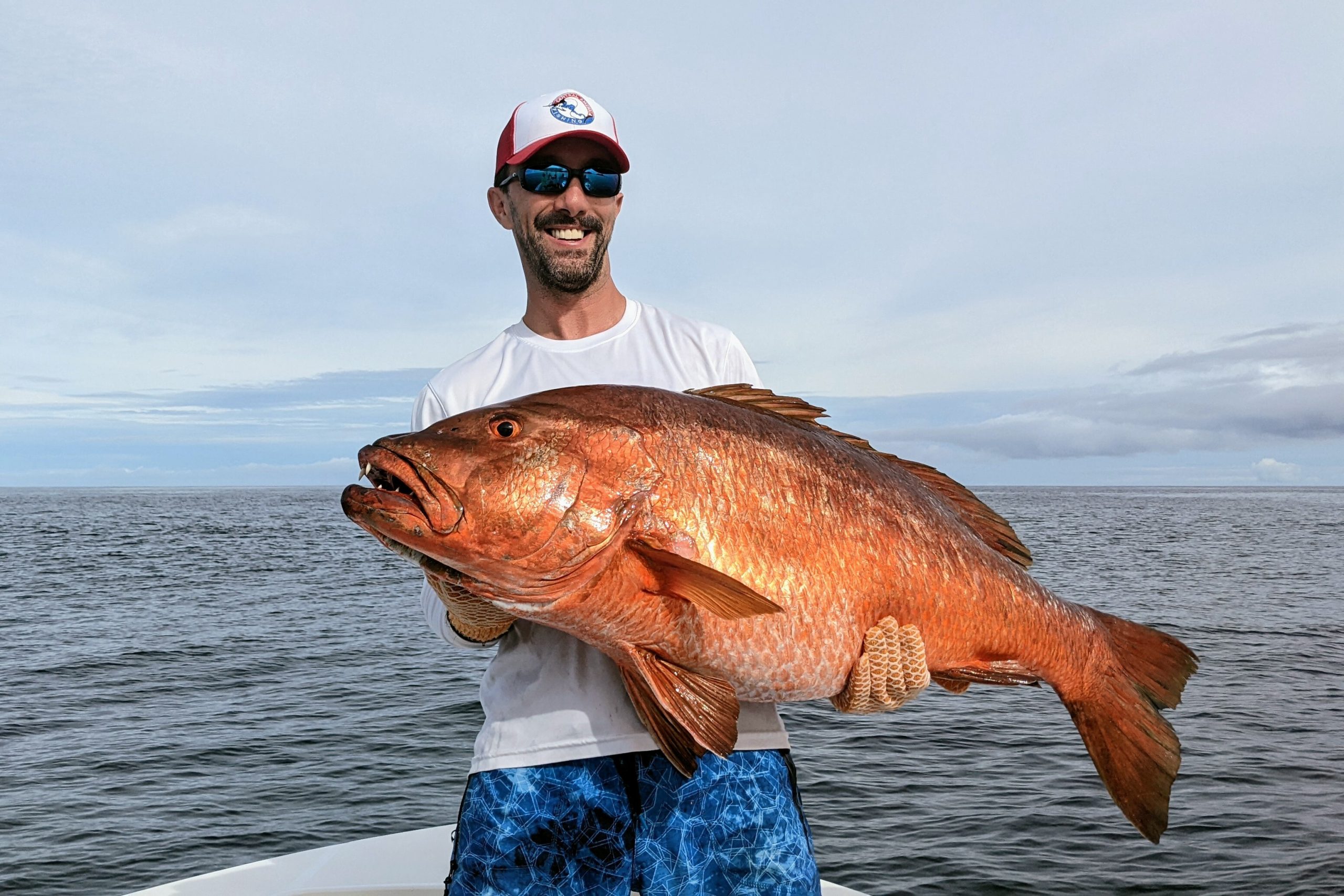
About the Author
I first visited Costa Rica during a semester abroad in 2003 and instantly fell in love with the language, culture, and natural beauty. I caught my first roosterfish on that trip, and ever since then I knew that I wanted to live here. After graduating in 2004, I worked for a year in the corporate world, but I was unhappy and unstimulated, so I returned to live in Costa Rica full time in 2005. Today I can proudly say that I’ve been in Costa Rica for half of my life, I met my wife here, and my two boys were born here so they are “Ticos”.
I’ve been working in the sport fishing industry in Central America for twenty years, I’ve had articles published in fishing magazines, hosted fishing TV shows, fished in several tournaments, and I’m a four-time IGFA trophy club member. I am however most proud to say that 40% of our anglers are repeat and referral guests. I’ve personally visited every destination, hotel, and fishing lodge that we partner with so that your next vacation with us is one of the best you’ve ever had.
Chris Atkins - Angler & Owner of Central America Fishing
All fishing vacations booked with Central America Fishing include the following:
- Free Vacation Planning (no fees + direct rates)
- VIP Airport Meet & Greet upon arrival into SJO
- Private, air-conditioned transfers with English speaking driver.
- Luxury, private accommodations hand-picked and customized for your group. Choose between private condos & villas, luxury beach resorts, exclusive boutique hotels, and fishing lodges.
- Private fishing charters
- All eco / adventure tours you’d like to include
- All Costa Rican taxes
- Free quotes on travel insurance
- Pre-arrival assistance with dinner reservations, tee times, pre-stocking your condo or villa, hiring a private chef, and special requests.
- 24/7 support once you are here in country
